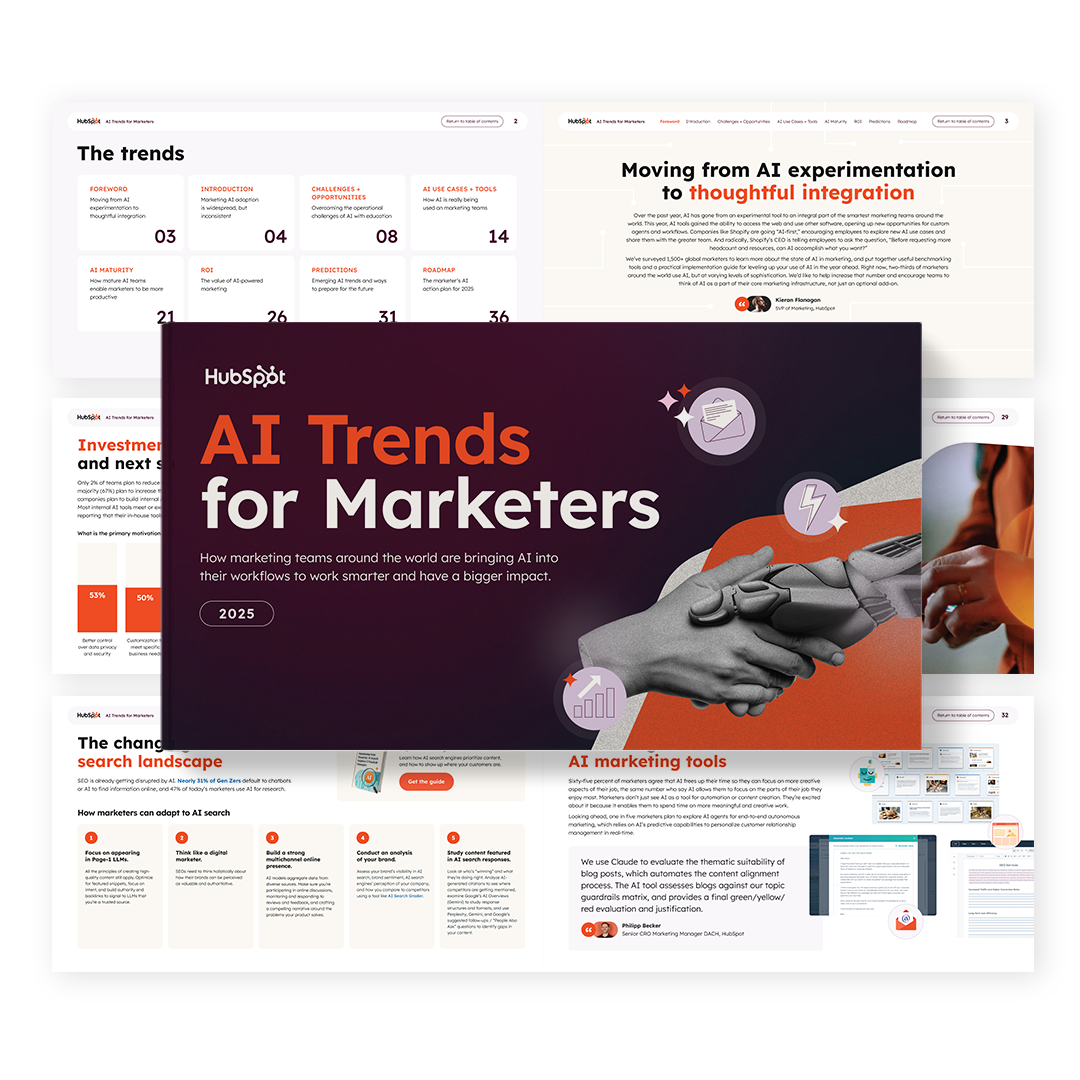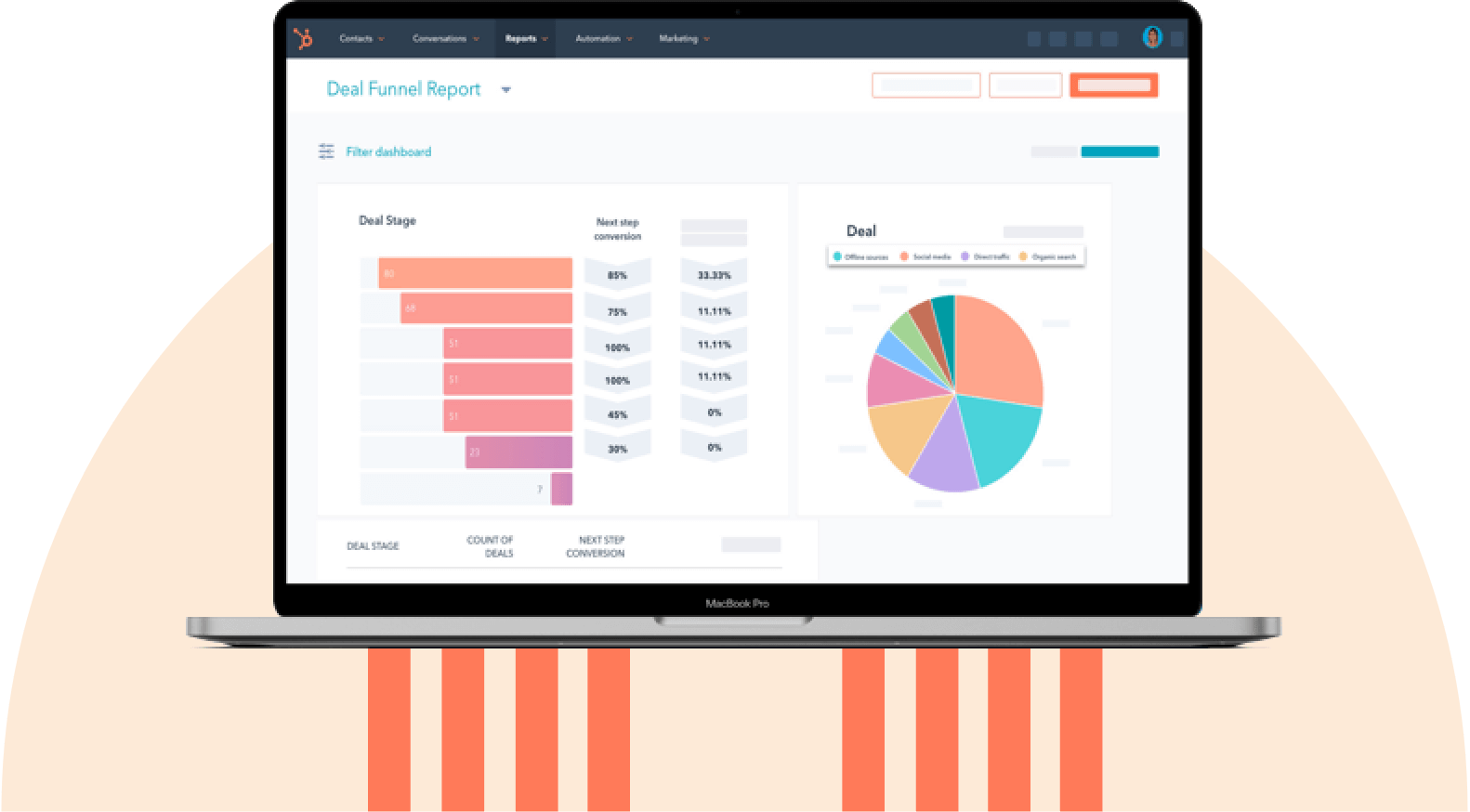That put a sour taste in my mouth regarding using AI for my small business. And it was quite some time before I tried it myself. Cut to the present day, and I lean on ChatGPT to brainstorm use cases for products, concepts, or other ideas I’m writing about (you’ll see me use it to research use cases for this very article a little later on). I find it helpful and a positive experience, but I always cross-reference with other information sources.
Aside from ChatGPT and my specific use for it, plenty of other AI tools on the market can help your small business. And I road-tested 21 of them right here.
Table of Contents:
How AI Can Help Your Small Business
First, consider these three ways AI can support your small business:
1. Customer Support
AI opens up the potential for small businesses to offer 24/7 assistance to their customers. According to our most recent State of AI Report, customer service professionals cite this as AI's biggest benefit. This round-the-clock support is driven mainly by AI-powered chatbots and self-service tools.
Aside from 24/7 support, 84% of customer service reps find AI makes it easier for them to respond to support tickets. One reason for this is AI’s capacity to prioritize tickets and then route them to human agents.
I interviewed Appareify Co-Founder Nora Salama about the pros of AI in customer service. They had this to say about support ticket prioritization:
“We recently started to utilize generative AI tools that can analyze CX requests based on sentiment, intent, and language before appropriately categorizing tickets,” says Salama. Doing so has helped Appareify "prioritize tickets, send tailored responses, and even more easily assign them to the agent that is most qualified to address the issue with speed and efficiency.”
2. Marketing and Sales
Nearly 90% of marketing professionals find that AI improves content quality. Meanwhile, 80% of bloggers say AI enhances user experience and can help improve their SEO efforts.
Regarding sales, prospect outreach is a widespread use case, with 86% of sales pros finding generative AI an effective means to craft prospecting messages. A further 72% say AI helps them to build rapport with prospects much quicker.
A cautionary tale: I think by now, we’ve all fallen foul of AI/automated sales outreach in some way.
Be that an obviously AI-generated comment on LinkedIn that parrots your post back at you, adding nothing insightful or new, or a random email from a stranger advertising an irrelevant service that can in no way help your small business.
Aaaand … it feels icky. Moreover, it leads to annoyance and frustration rather than a sale.
With that in mind, if you use AI to help with your sales prospecting, don’t use it as a substitute for critical thinking or your humanity in general. First, make sure the people you reach out to can actually benefit from what you offer in some way. Second, personalize your outreach messages so they don’t feel like just another annoying LinkedIn pitch slap or cold outreach email.
3. Productivity
More than 60% of business leaders across industries have invested in AI to help their employees. Of those, 72% report an uptake in employee productivity. That’s no surprise, given that 95% of professionals say AI tools allow them to spend less time on manual, repetitive tasks.
The result? Nearly 90% have more time to spend on the most impactful parts of their role.
No matter what you use AI for, remember that there are limitations. According to International SEO Consultant Aarne Salminen:
“In my opinion, businesses should take care about what they agree to when signing into ANY tool. Let‘s say they feed their business data to such a tool. Does it give the tool owner the right to use that data as they please? That should be on any business’s radar, at least.”
Looking for an all-in-one AI solution for marketing, sales, and customer support workflows? Get started with HubSpot AI today.
21 Best AI Tools for Small Business
To figure out which tools stand out from the hype, I road-tested 21 affordable AI tools for small businesses. Here's what I found.
1. HubSpot
HubSpot is a CRM platform that can help you simplify your processes across sales, marketing, and customer support. The platform integrates AI recommendations across these areas to help you improve anywhere from inbound marketing campaigns to your business operations.
HubSpot’s CRM is free. Paid plans start at $50 monthly and vary based on team size and tier subscription tier. You can find core AI features like content creation, deduplication features for your lists, emails and workflows, and HubSpot’s AI-powered companion, Breeze.
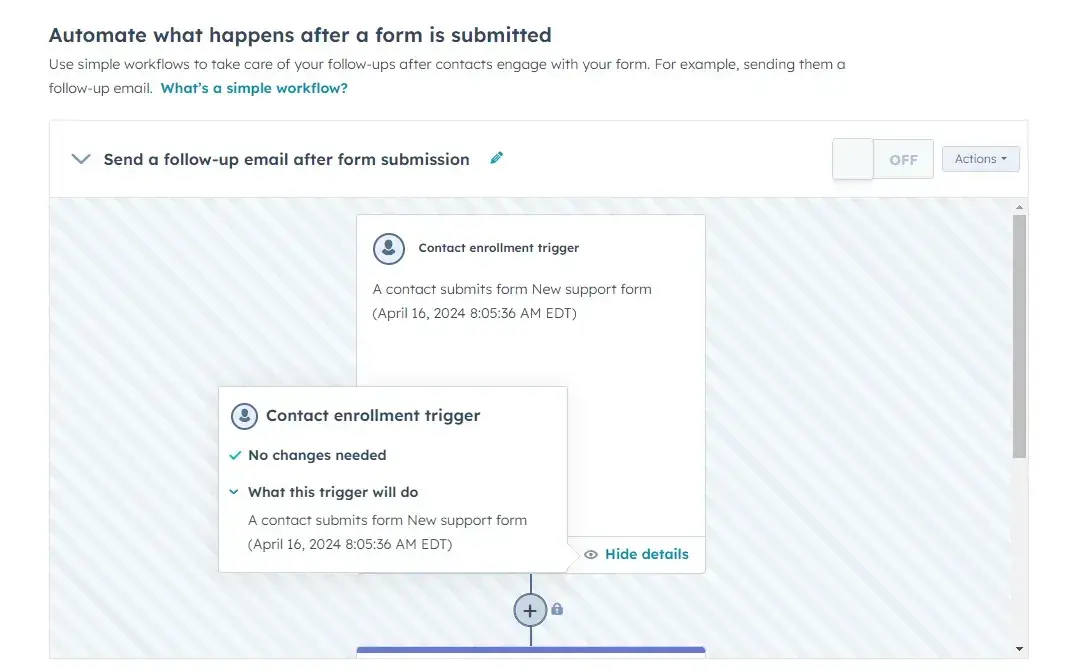
Pros and Cons
When HubSpot says it’s an all-in-one platform for marketing, sales, and customer support, they mean it. It’s hard to find another solution that offers the same resources for businesses of all sizes.
And if you’re a marketer looking to tackle your work with ease, you can also use HubSpot to customize most (if not all) of your content needs, from website design to social media scheduling and publishing. I think that would be helpful for newer businesses just getting started in, dare I say it… “the digital realm.”
That said, HubSpot’s biggest strength is also potentially a drawback, depending on what you need the tool for and how much you need it. The crux? If you do not use HubSpot as an all-in-one tool, it might not be worth the investment.
Best for: The Starter Customer Platform is ideal for small businesses.
What I Like
When it comes to Breeze and its flexibility in HubSpot’s Marketing Hub specifically, I’ve really enjoyed its ability to quickly generate a variety of information based on what I’m looking for ... For example, when editing a blog post in HubSpot’s 53 portal, Breeze appears (its presence is indicative with a little star icon and a ‘Refine’ button, so it’s super easy to find) if I highlight paragraphs.
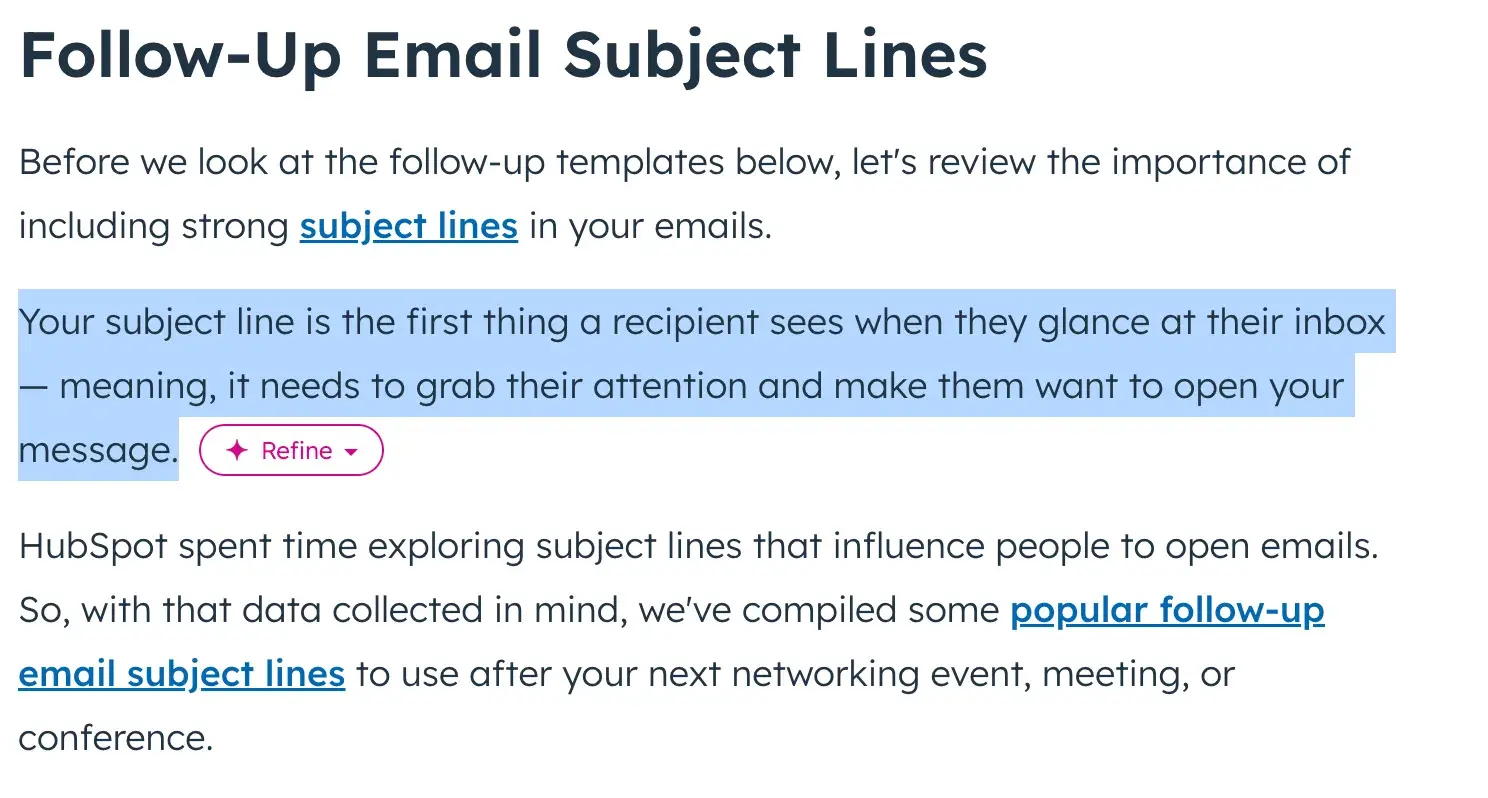
From there, it suggests a few options: Rewrite, Expand, Shorten, Change Tone, and (my personal favorite) Something else.
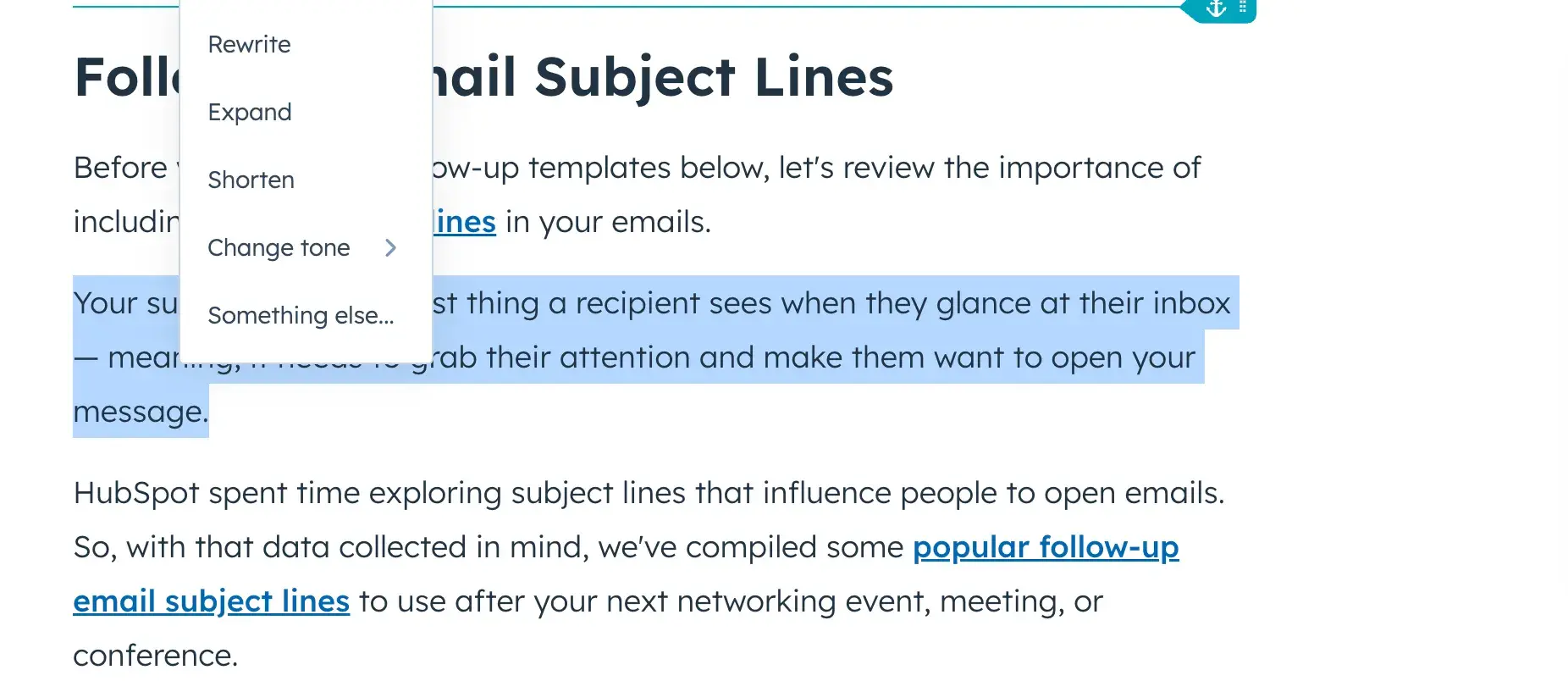
To test it out, I chose to ‘Rewrite’ the highlighted paragraph.

Here’s what it gave me in return (check out that second paragraph – looks pretty good, right?):
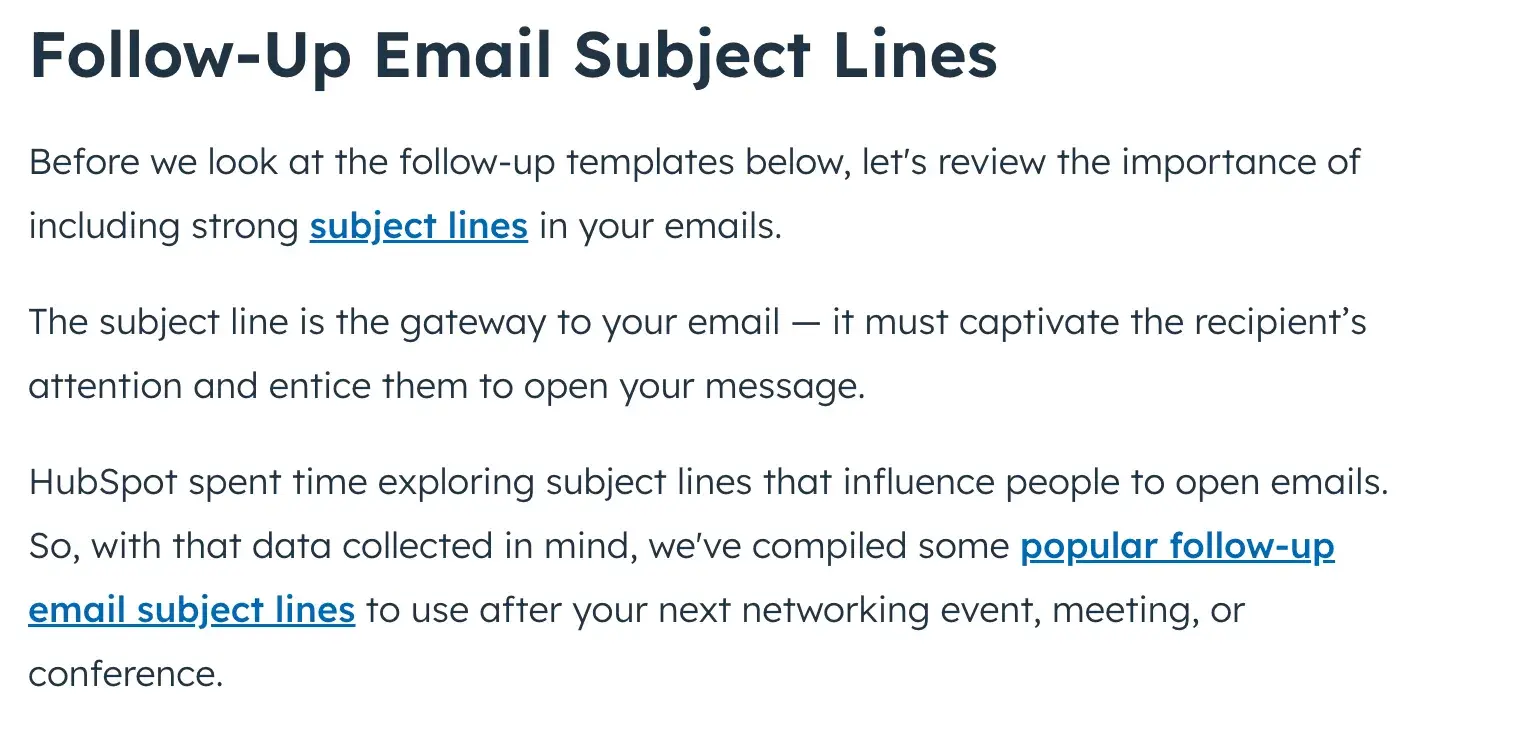
2. Buffer
Buffer is a social media toolkit that helps you write, schedule, and publish social media content.
Buffer and I go way back to when I first dipped my toes into digital marketing. In 2017, I started a blog in my spare time. Through that personal project, I began to build up a social presence and realized I dug into this whole marketing thing.
Long story short, around the same time, I took on the company blog and social media at my day job. This happened because a) I’d started to develop the relevant skill set, and b) there was a business case for it. For context, I was an office admin for a small training provider in the U.K.
Not long after that, I took on my first freelance client, another small business, and offered this same service (managing their blog and socials).
Buffer’s free plan was a go-to for marketing at my day job, for myself, and for my freelance client. So, I know that this social media tool is great for small businesses and freelance marketers who work with small businesses.
The free plan includes planning and publishing tools, the landing page builder, and Buffer’s AI Assistant for up to three social media channels. You can also schedule 10 posts at a time per channel, which is amazing for a free plan.
Pros and Cons
It’s affordable and has a user-friendly interface that makes the scheduling tool easy to use. The drag-and-drop feature for posting content with images is a massive time saver, too.
I can also see the AI Assistant speeding up the publishing process — provided you prompt it well enough to deliver a decent output. I tried this feature and wasn’t massively impressed with the writing. But, to be fair to Buffer, my prompt wasn’t that detailed.
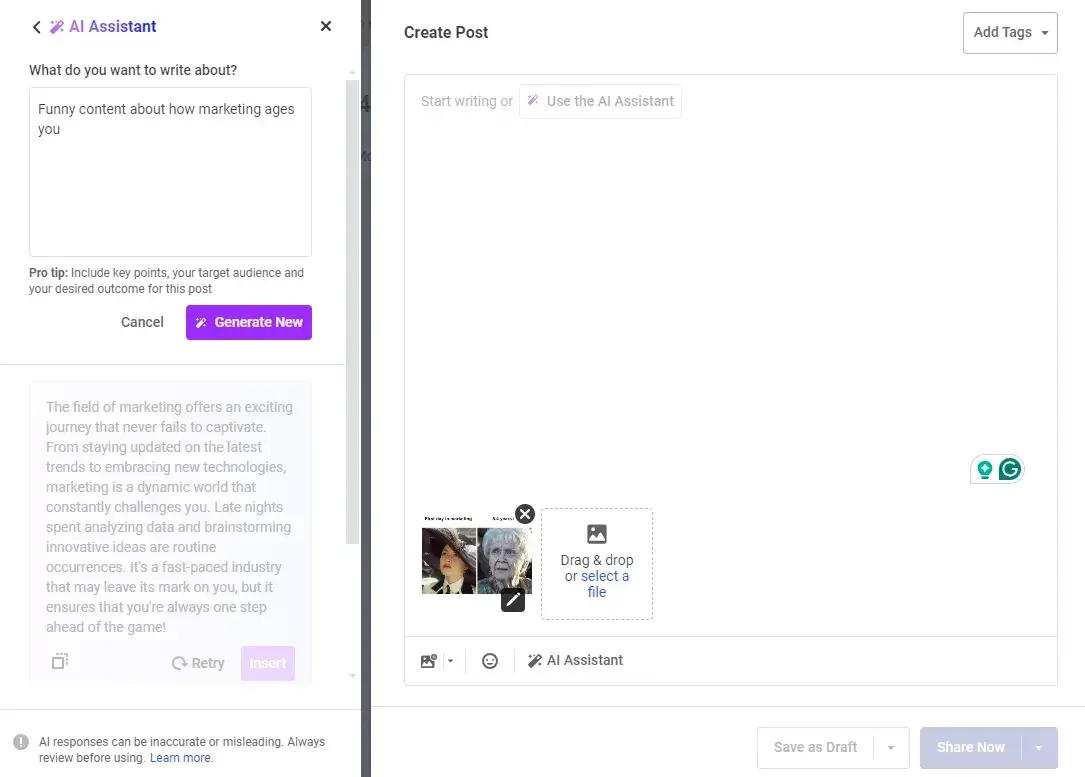
I also love the calendar layout. It makes it easy to visualize your content schedule. What I would say (having been bitten by this before) is to double-check that the time zone on the schedule is correct (I once scheduled posts for a client in the U.S. without changing the time zone setting, and the posts went out during the very early hours of the morning. Awkward).
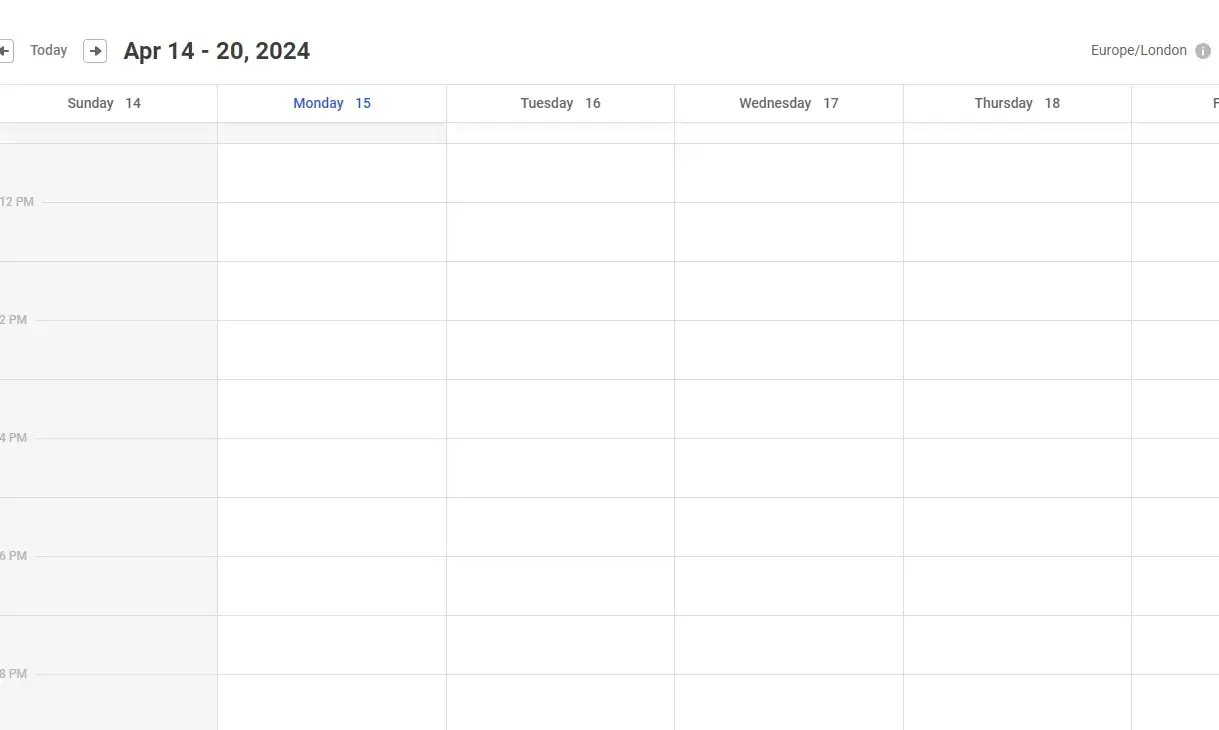
Here’s another thing to watch: When I’ve used this tool, I quickly noticed that it can be glitchy when scheduling posts through a LinkedIn page rather than a profile. Sometimes, the posts don’t go live, or the images are small when published.
Additionally, in my experience, Buffer sometimes randomly disconnects your social profiles from the platform. And that means you’ll lose any content you scheduled in advance. I recommend having a backup copy of your social content on a Google Doc or something similar. Then, even if you have to reschedule your posts, at least you don’t have to write them from scratch.
Best for: Small businesses and teams, freelancers, and social media marketers.
What I Like
I like the same thing now that I did back in 2017… It’s so affordable. If you’re a small business, you’re likely not on all the social media platforms. And that’s actually a good thing. When you have a small team (or it’s just you doing everything), you’ll probably have more joy focusing on one or two platforms rather than spreading yourself too thinly.
Anyway, that means the free plan should be more than enough to help you start scheduling posts and building a social presence. On the free plan, you can schedule 10 posts per channel. So, if you schedule two posts per week on Instagram, you can have up to five weeks' worth of content in the hopper. Not bad!
But if you’re looking to stay within the HubSpot ecosystem, Content Hub does just about everything that Buffer can. Now that it’s fueled with Breeze technology, it’s easier than ever for marketers to attract audiences, keep a pulse on what’s keeping them engaged, and design assets in-house. Just some food for thought.
3. Jotform
Jotform AI Agents shine when it comes to automating workflows and improving customer experience. Instead of just displaying static forms, these agents actively guide users, provide real-time assistance, take calls, and even trigger automated actions like sending emails, scheduling meetings, or processing requests.
Source
Pros and Cons
The flexibility of Jotform’s AI Agents is impressive. You can create an agent from scratch, use a pre-built template (there are over 7000 of them), or even generate one that mimics your own style and responses. These AI-powered assistants can be embedded into websites, shared via QR codes, or deployed across different messaging apps - they’re adaptable to various business needs.
Security is another strong point. Jotform AI Agents operate within Jotform’s secure infrastructure, ensuring data privacy and compliance with industry standards.
That said, while Jotform AI Agents are excellent for interactive forms and customer support, they may not be as robust for complex AI-driven conversations compared to specialized chatbot platforms. Users looking for deep, AI-powered conversational logic might need additional customization.
Best for: Businesses, solopreneurs, and teams that rely on customer interactions and forms but want to automate the process across different platforms.
What I Like
Jotform AI Agents transform passive forms into dynamic, interactive experiences. The ability to collect data, assist users, and automate workflows in real time is a game-changer for businesses looking to enhance engagement.
I also appreciate how easy it is to set up and train. Whether you start from scratch or use a template, getting an AI Agent up and running is straightforward. The multi-platform deployment is a big plus—being able to use them on WhatsApp, Messenger, and websites makes Jotform AI Agents really versatile.
For businesses that rely on forms and customer interactions, Jotform AI Agents provide an effective, automated way for engagement.
4. Grammarly
Grammarly offers assistance with spelling, grammar, and writing. Aside from Buffer, Grammarly was (and still is) an integral part of my tech stack while working for small businesses — and being a small business myself, might I add.
Back in 2017, and for a few years after, I was still using Grammarly’s free plan to help me proofread blog and social media content. The free plan was perfect for what I needed back then and kept my business costs low.
It wasn’t until I specialized as a freelance writer that I signed up for Grammarly Premium, and honestly, I’ve never looked back. Now, I might not always listen to what Grammarly suggests, but I feel more confident having a second pair of eyes, as it were, on my writing. Whether you want to edit your emails to be error-free or you need help writing them from scratch, Grammarly can help.
The free plan includes basic grammar and spelling suggestions, a tool to see your writing tone, and the ability to generate text with 100 AI prompts.
Pros and Cons
One of the biggest pros is that, even with the free version, you can get a Grammarly browser add-on. I love this because it allows me to easily integrate Grammarly’s features into my LinkedIn posts, emails, and Google Doc content.
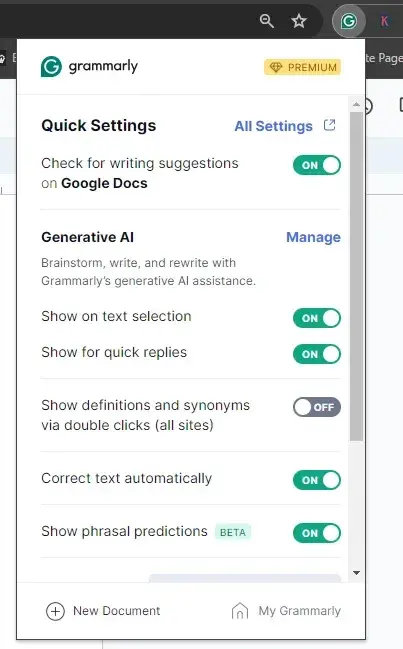
That pro also nicely segue us into a con. This could just be my experience, but sometimes, I find that Grammarly is temperamental when used within Google Docs. And the longer the document, the more temperamental I find it to be.
Sometimes, it won’t flag errors, or it will keep flagging a mistake that you’ve fixed. The page might also jump around a little. But bear in mind, sometimes I’m writing or editing Google Docs that are over 30 pages long. Yep. You heard that right, my friend.
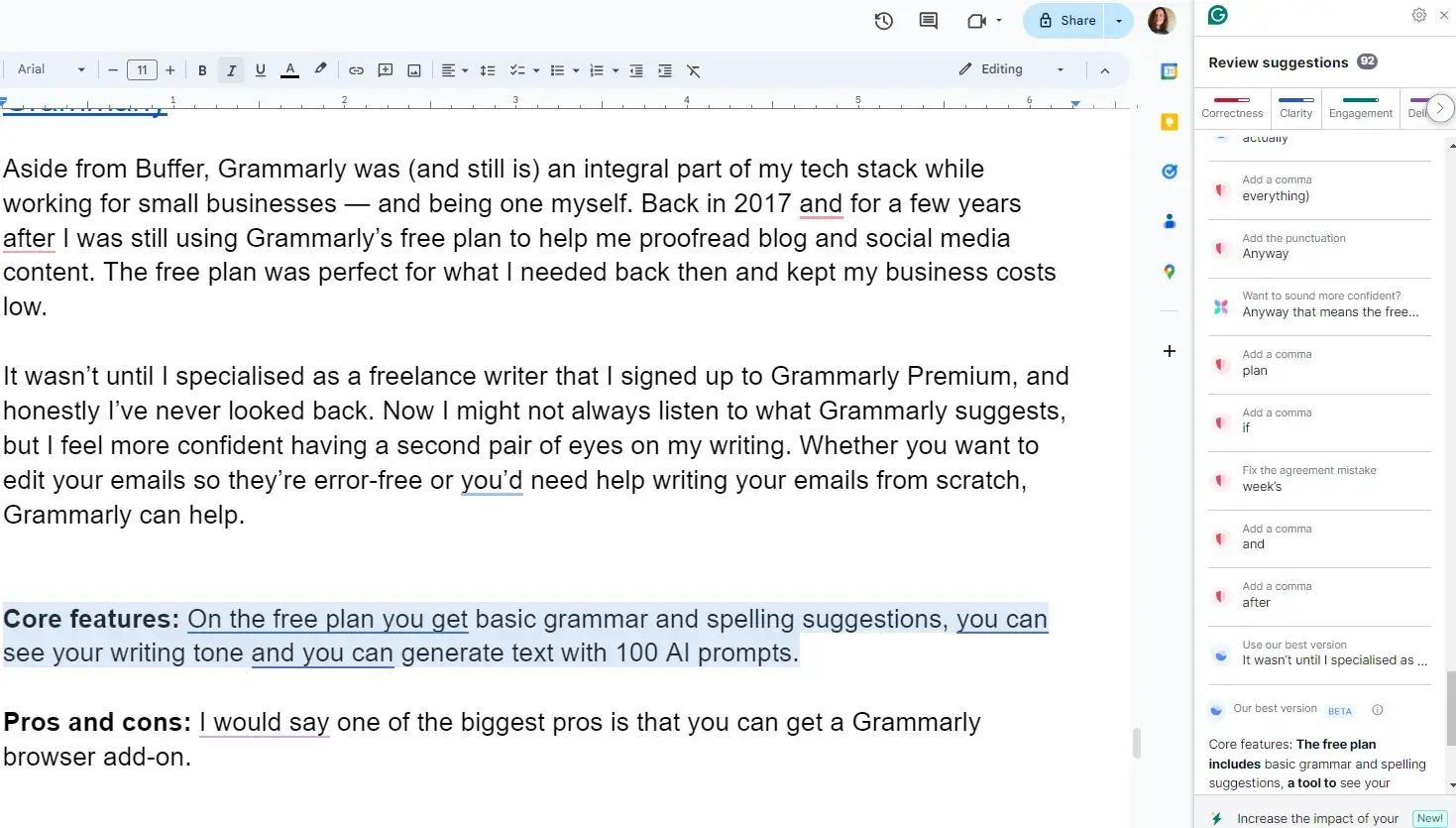
I will copy and paste the Google Doc content into a Grammarly document to counteract this. But that can mess up the formatting, and if you’ve already added images to your Google Doc, the tool won’t copy and paste them into the Grammarly document. There might be a quick fix; I’ve not found it yet.
Best for: Small businesses and teams, freelancers, and marketers.
What I Like
Overall, Grammarly offers the best suggestions for making your writing more concise. I prefer it to, say, the Hemingway App, which I think sometimes oversimplifies text to the point that it loses energy and character.
Grammarly is also one of the better AI business tools I’ve played with. However, in my humble opinion, it’s no replacement for a human editor.
5. DreamHost AI Business Advisor
I'm always interested in new tools that can make running a business more efficient. One such tool is DreamHost's AI Business Advisor, designed to offer tailored business insights using artificial intelligence.
Whether you‘re new to the concept of AI-driven guidance or just exploring your options, this feature aims to simplify decision-making and provide recommendations that fit your specific needs. Let’s take a closer look at what the AI Business Advisor can do and how it might benefit your business.
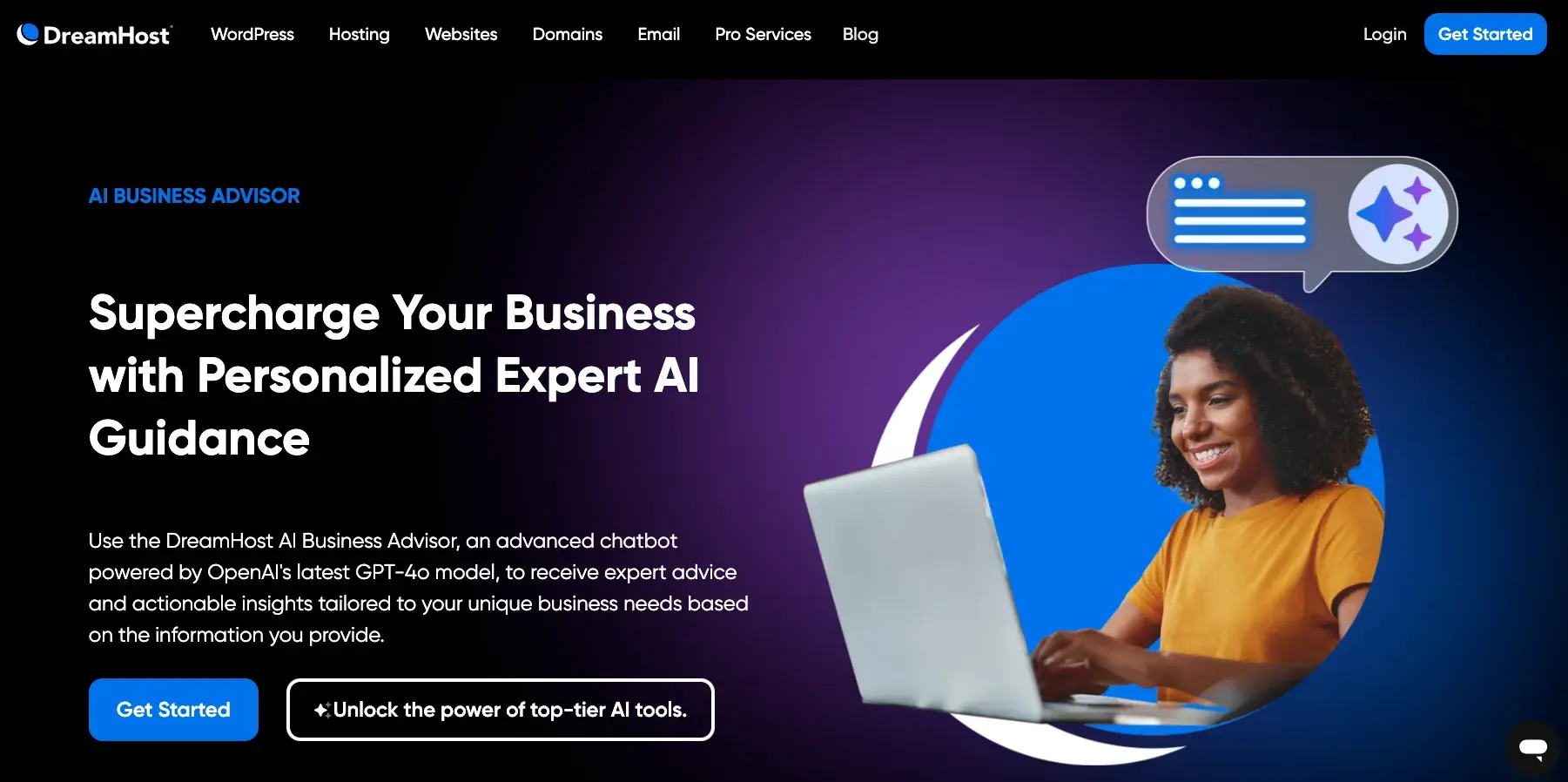
Image Source
Pros and Cons
The DreamHost AI Business Advisor offers several advantages that can make managing multiple businesses or domains more efficient. One of its standout features is the ability to create different profiles for each business, allowing for tailored advice specific to each one.
The tool also incorporates a memory function that remembers details about your business and past interactions, leading to faster and more personalized recommendations over time. Powered by ChatGPT 4.0, the AI Business Advisor is not only quick but also user-friendly, with a prompt library that helps you get started right away.
However, like many AI business tools, there is a learning curve involved. While the prompt library is helpful, complete beginners might still face challenges in fully harnessing the tool's capabilities. It requires some exploration and experimentation to get the most out of it, which might be a hurdle for those unfamiliar with AI-driven solutions.
Best for: This tool is best suited for entrepreneurs and small business owners who manage multiple ventures and want personalized, AI-driven guidance to streamline their decision-making process.
What I Like
What stands out about the DreamHost AI Business Advisor is the ability to create and manage different profiles for each business or domain. This means the tool can deliver advice tailored specifically to the needs of each venture, making the recommendations more relevant and actionable.
Unlike some AI tools that require constant re-prompting and relearning, the AI Business Advisor‘s memory function significantly reduces this hassle by remembering key details about each profile. This not only saves time but also enhances the overall user experience as the tool becomes more attuned to each business’s unique goals and challenges over time.
6. Madgicx
Madgicx is an AI super app for Meta ads that offers tools for ad optimization, automation, creation, and analytics. It has an AI Creative Workflow for ad creation, an AI “ad agent” for optimization and ad management, and a cross-channel reporting solution for Meta, Google, TikTok, Shopify, and GA4 called One-Click Report.
Madgicx’s pricing starts from $31/month for businesses with small advertising budgets and offers a free 7-day trial. The pricing depends on your monthly Meta ad spend and on the number of Meta ad accounts you connect. You may purchase specific tools separately, such as the AI Creative Workflow ($29/month) or the cross-channel reporting solution (starting from $29/month).
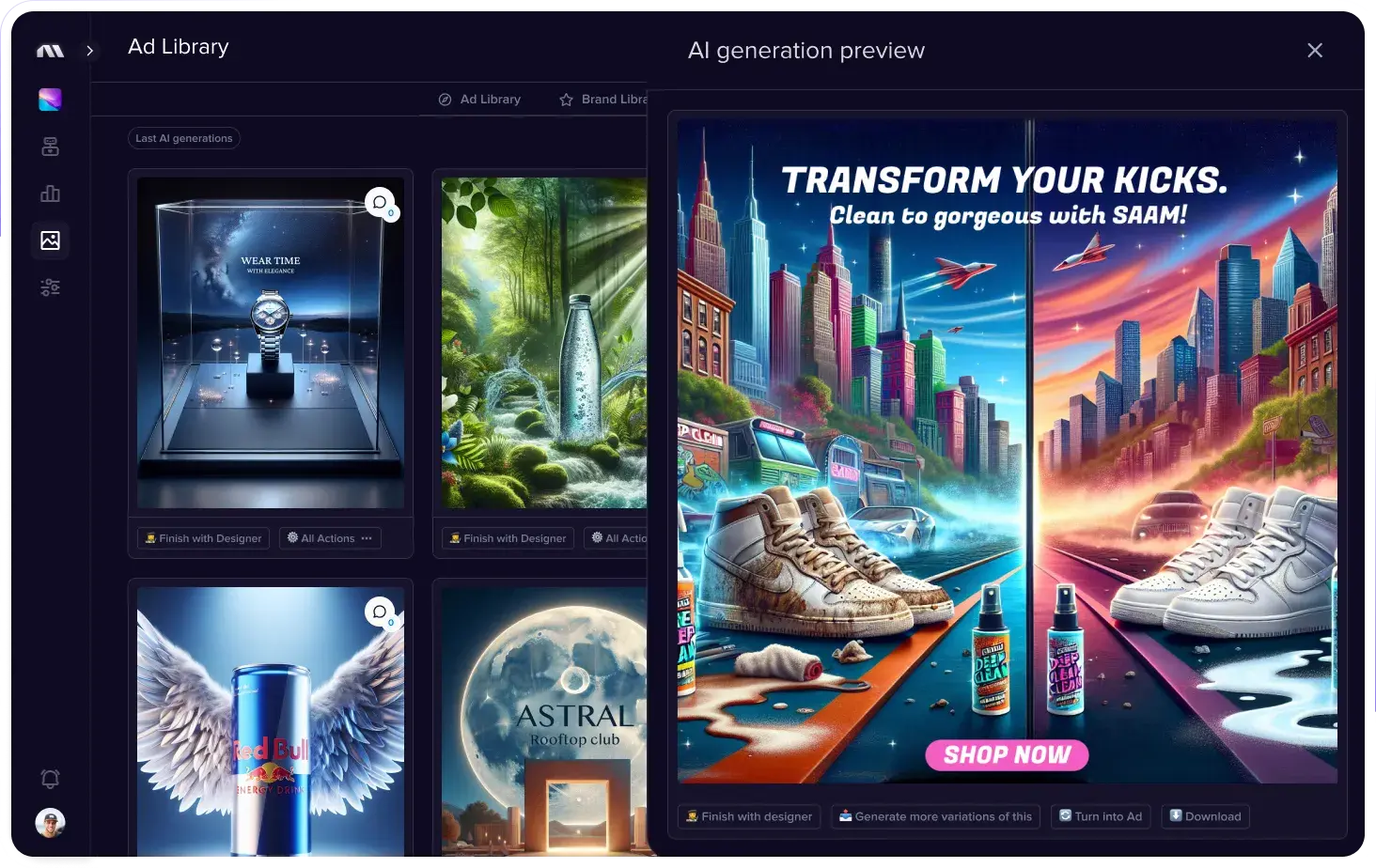
Image Source
Pros and Cons
Madgicx’s primary advantage is that it contains all the tools needed to create, manage, and optimize Meta ads in one app. It saves its users time and helps them improve their ad results.
Madgicx’s AI tools help small businesses bridge crucial gaps: the lack of expert knowledge in Meta ads and the lack of design and production resources.
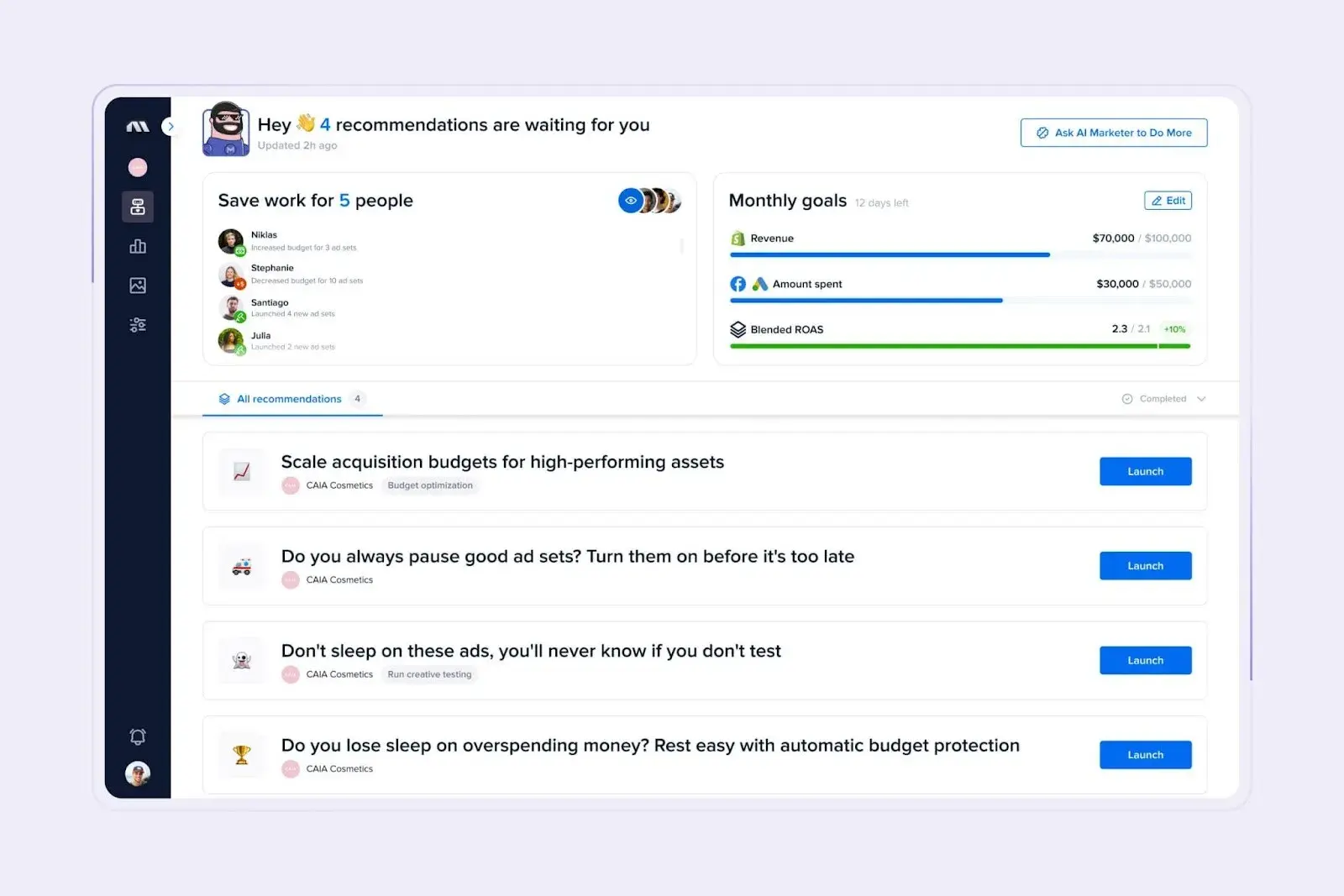
There might be a learning curve when you start using Madgicx — especially if you buy the full package, but the company offers chat support, video tutorials, and a knowledge base to help those who are less experienced with Meta ads.
Best for: Small businesses and digital advertising agencies.
What I Like
My favorite and newest tool is the AI Ad Generator, which allows users to create new ads based on examples from Madgicx’s Ad Library, their photos and product images, or a written brief. It’s part of Madgicx’s Creative Workflow, which starts with Creative Insights, an AI creative analytics tool, and takes you through finding inspiration in the library through creation and design (they also offer design services) to launching your ads from the Madgicx app.
Next, Madgicx has an AI Marketer, which is like a personal AI ad agent that tells users exactly what to do next to optimize their ad accounts. Madgicx also offers its users a unique advantage: exclusive access to AI bidding, a Meta feature not available in Ads Manager or other software solutions. This feature empowers users with optimized budget allocation across audience segments within ad sets, enhancing their ad performance.
Between tracking ad campaign performance and boosting posts, things can get clouded. If Madgicx feels like a lot to tackle, HubSpot Marketing Hub could potentially be a better tech stack fit, especially if your goal is to view your metrics and cross-channel efforts in one place. With Marketing Hub, it’s easier than ever to build campaigns that help your small business grow; if you don’t believe me, try it out for yourself.
7. Notta
Notta is an AI meeting assistant designed to improve productivity by recording, transcribing, and summarizing your meeting conversations, whether in-person or virtual.
It works across major video-conferencing apps such as Zoom, Google Meet, and Teams. When you connect Notta to Google or Microsoft Calendar, the Notta Bot will auto-join the scheduled meetings, ensuring that meeting notes are taken even if you are absent.
Notta’s AI capabilities go beyond just meeting transcription. When the meeting is over, it generates an automatic summary in seconds, extracting key topics, action items, and relevant information from the lengthy transcript, saving you valuable time.
What makes Notta an indispensable tool in your workflow is its seamless integration with Notion, Salesforce, and hundreds of other apps via Zapier — syncing meeting notes is a breeze.
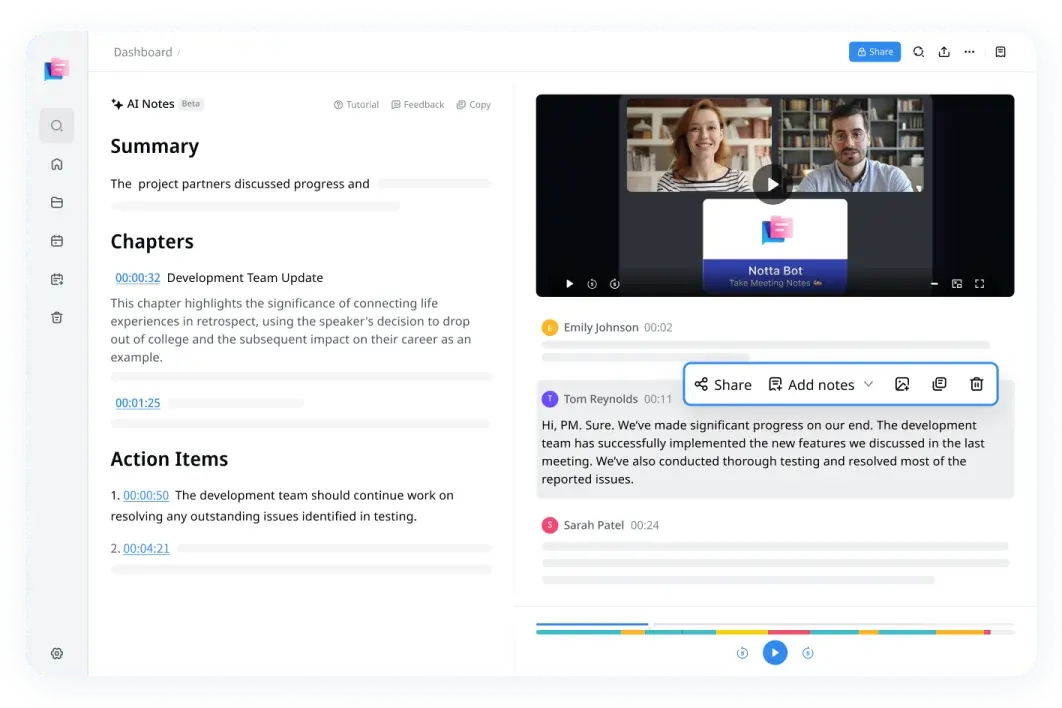
You can start using Notta with its Free plan, which offers limited functionalities. For teams that need advanced features like automated summary and video recording, go with the Business plan that starts at $16.67 per month.
Pros and Cons
One of Notta's biggest strengths is its template library, which helps you extract information tailored to specific meetings. For example, if you just conduct a proposal meeting with a client, you may select the ‘Sales Pitch’ template to generate a meeting summary that includes customer insights, sales proposals, and a budget.
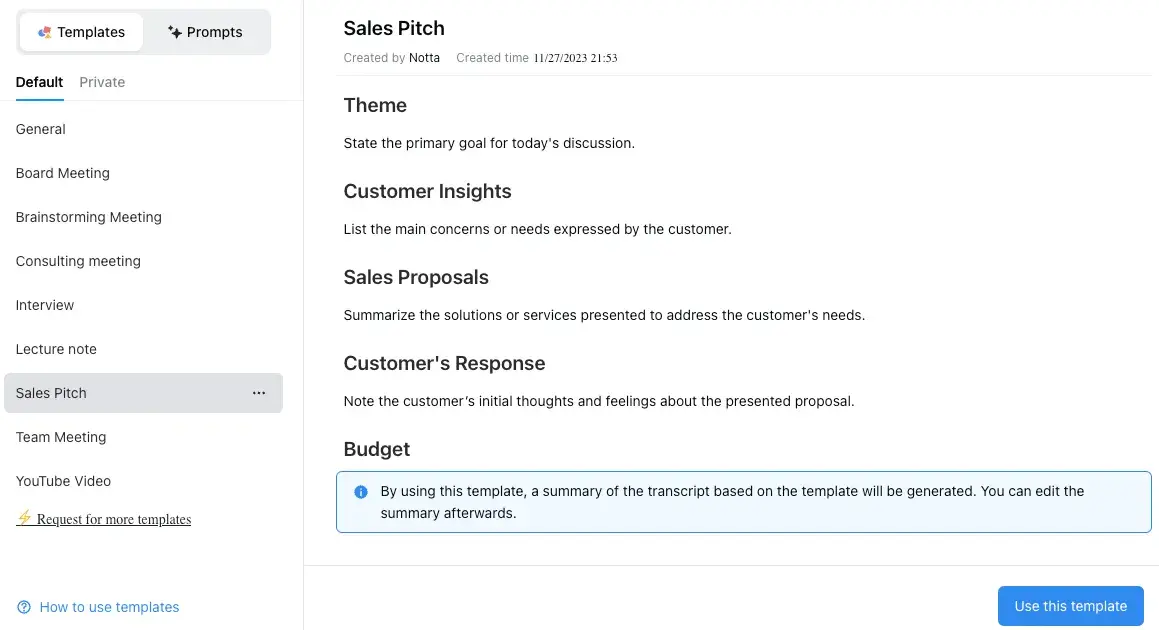
Another standout feature is Notta's ability to generate live transcripts for monolingual and bilingual meetings. That said, the user interface can feel a bit clunky and users sometimes need to think a minute before moving to the next step.
Best for: The sales and customer success teams who conduct plenty of meetings.
What I Like
I like that you can share a clip from the meeting records, ensuring that viewers receive the most relevant information without needing to sift through the entire recording. Additionally, you can share meeting notes with a password to protect sensitive information.
8. Visme
Visme is an all-in-one platform, a no-code solution for creating nearly all marketing material including graphics, logos, infographics, presentations, white papers, email newsletters, etc.
Being a marketing professional, but a non-designer, I always search for easy-to-use tools that make graphic design efficient. I came across Visme while creating a winning sales pitch deck. I was blown away by the features Visme offers. Its user-friendly interface, a massive library of templates, low learning curve, and AI-backed features make Visme one of the sought-after design platforms in the market. Using Visme is easy, & straightforward. The process is fast and offers a design process free of unnecessary glitches. 
The free plan is great for individuals and entrepreneurs holding various hats. They can brainstorm, store, create, improve, and market every kind of marketing material from a single place. For advanced design features and premium templates, you can buy it's one of the affordable premium plans.
Visme is your go-to platform for brainstorming all your visual content ideas using its Online Whiteboard Tool. You can create flows, wireframes, sketches, and plans to give life to all your creative ideas. Expand your creativity using design elements like emojis, icons, arrows, illustrations, etc. If you have a team, just share Visme’s live link for collaboration on your design project.
Pros and Cons
Visme leverages artificial intelligence to streamline the creation of visual content, enhancing both speed and efficiency. With Visme’s integrated AI Image Search tool, users can easily locate relevant images or designs from across the web. If the available options do not meet your needs, the AI Image Generator allows you to produce a unique image tailored to your specific prompt. Additionally, the AI Touch Up tools and AI Writer facilitate the refinement of designs and the crafting of marketing copy, respectively.
These features collectively expedite the graphic design process, enabling the creation of impressive visuals with minimal effort. Visme offers fully customizable templates for various purposes, including web graphics, infographics, forms, surveys, and presentations, all of which are conveniently accessible through Visme’s dashboard. Furthermore, Visme provides over 40 chart options to effectively present data within your sales pitch.

Customize your sales pitch to your liking using the design blocks, graphics, icons, and illustrations, available to the left in the dashboard. Great visuals coupled with immense creativity will make a solid case for your product or service.

Visme houses thousands of fully customizable design templates. You can choose any of them that fits your business needs. However, if you want, you can create it from scratch using its drag-and-drop functionality or use Visme’s AI Designer to have the initial layout and customize it to your liking. I tried the following prompt below, and the results were stunning
Best for: Entrepreneurs wearing multiple hats, small business owners, teams, freelancers, and social media marketers.
What I Like
Visme offers an integrated and efficient approach to creating and marketing visual content. Within Visme’s dashboard, users can engage in brainstorming, ideation, planning, creation, and marketing of visual content. The platform also allows for the storage of brand assets in the Visme Brand Kit and facilitates real-time collaboration by sharing live links with team members.
A notable feature is its social media scheduler, which positions Visme as a comprehensive tool for both content creation and scheduling across social media platforms. This functionality eliminates the need for multiple marketing tools, enabling users to schedule content directly for platforms such as Instagram, Facebook, LinkedIn, Slack, and others without relying on third-party applications.
9. ClickUp
ClickUp is the everything app for work—an AI-powered platform that helps small businesses simplify operations, reduce tool sprawl, and automate work intelligently. From managing client deliverables to tracking internal projects, ClickUp converges everything you need to get work done into one unified workspace.
ClickUp AI Agents play a key role by automatically responding to custom triggers—whether that’s assigning onboarding tasks, notifying clients, or generating documents.

For example, when a task moves to "Done," ClickUp Brain can trigger an agent to update next-step tasks or notify team members, streamlining workflows without manual intervention.
Enterprise Search powered by ClickUp Brain allows users to query across tasks, docs, comments, and integrations. So you can instantly retrieve contextual answers like project status or prior meeting outcomes without switching tools.

Additionally, ClickUp Brain Max gives users a voice interface with talk‑to‑text capabilities. You can speak tasks, summaries, or action items from a client call, and AI will log them directly. The platform’s multi-model architecture ensures that you get contextual output tailored to tone and intent, whether you’re writing client emails, internal summaries, or task briefs.
Pros and Cons
ClickUp is effective for small teams looking to automate tasks, streamline client communication, and eliminate tool overload. AI Agents and Enterprise Search accelerate coordination and reduce manual effort, while voice commands bring flexibility to operations.
However, achieving full value does require setup: configuring triggers, enabling roles, and training ClickUp Brain to match your preferred workflow. Many core features are free, but full AI usage requires a paid plan plus add-on access unless you are on the Enterprise plan.
Best for: Ideal for small business leaders and lean teams who need integrated AI-powered workflows—with fewer tools and more impact.
What I Like
ClickUp simplifies scale: you can set up intelligent workflows, automate meeting summaries and client updates, and run operations from one platform. It practically eliminates AI tool sprawl and feels like adding a virtual team member, without adding overhead.
10. FlexClip
FlexClip emerges as a powerful, user-friendly AI video editor tailored for small businesses seeking to create professional-quality content without technical expertise. Leveraging AI-driven tools like text-to-video conversion, automated script generation, and AI-enhanced image creation, FlexClip streamlines the video production process, enabling users to transform ideas into polished videos in minutes.
FlexClip's user-friendly drag-and-drop interface, along with over 6,000 templates and millions of stock media, is perfect for creating marketing content. It offers brand customization, team collaboration, and cross-platform compatibility. FlexClip’s AI automates tasks like auto-cropping and smart transitions, making it ideal for businesses seeking efficient, trend-aligned content creation without major software investments.
Pros and Cons
FlexClip AI Video Editor is incredibly user-friendly, making it a great choice for those with little to no video editing experience. Its AI-powered features make the editing process faster and more efficient. As a small business owner, it is beneficial to recognize the affordability of this tool, which offers flexible pricing plans that provide access to premium features without significant financial strain. The cloud-based nature of the tool is advantageous, as it allows for seamless access and collaboration on projects from any location, whether in the office or on the move. Additionally, the extensive range of templates facilitates the efficient creation of professional-quality content, thereby saving time while upholding high standards.
However, there are some downsides. For more advanced video editors, FlexClip may feel limiting, as it doesn’t offer the depth of customization and advanced audio features that other tools provide. The fact that it’s an online-only platform also means you need a stable internet connection to work, which can be inconvenient at times.
Best for: Ideal for marketing teams, content creators, and social media managers needing AI tools to streamline video production.
What I Like
FlexClip's intuitive interface is accessible for beginners, with customizable templates and AI tools speeding up content creation. Its royalty-free media collection and cloud storage simplify organizing and accessing projects, making video production efficient.
11. Divi AI
Divi AI is an all-in-one AI web design assistant that helps small business owners create and customize WordPress websites with ease. Divi AI has you covered whether you need an entire website, a single page, or just some fresh content and visuals. It takes the guesswork out of design by asking about your brand’s colors, fonts, and style preferences, or it can generate them if you’re starting from scratch..
Pros and Cons
Divi AI is deeply integrated within the Divi theme and builder, making it easy to use for anyone, regardless of design or coding experience. Its AI capabilities allow you to quickly create entire websites, a single page, or add fresh content to an existing page while ensuring your unique brand identity shines through.
The tool excels at understanding the context of your site and the specific post or page you’re working on. Whether you need website copy, blog posts, or on-brand images, Divi AI can generate it all with a high degree of relevance.
One of the best things about Divi AI is that you can set your preferences upfront so the AI delivers content and design elements that are ready for use. Once it's done, you can customize everything to your liking, as it's built on top of a page builder. This makes it a powerful tool to fast-track your design and content creation process.
When generating content for your website, you can specify keywords you’d like the AI to use, the length of the copy you’d like generated, and your tone and language. This can be very useful if you’re writing blog posts and want to optimize your content for search engines or a specific audience.
Best for: Small businesses, entrepreneurs, freelancers, and agencies.
What I Like
Divi AI makes designing stunning, professional-looking websites incredibly easy without hiring a designer. Its ability to generate entire layouts and customize content based on your site’s context saves time and effort.
12. Piktochart
Piktochart is a visual design tool that allows users to transform complex data into visually appealing graphics. This AI business tool is a popular choice to create long-form infographics in different formats, such as presentations or reports.
That’s how I came across the AI design tool myself, as I needed to create a progress report template to use for different projects. The only issue is I’m not a designer, so I needed a tool that could do the job fast and without much fuss. The free plan was great for my needs since I downloaded just one visual to reuse for different clients.
You can sign up for free, which lets you create and download a handful of visuals. Paid plans begin from $29/month for solopreneurs and small teams. There are also discounted rates for educational plans and nonprofit organizations.
Pros and Cons
Piktochart AI’s biggest strength lies in just how easy it is to use, especially for non-designers. You share a prompt, it generates dozens of templates in seconds, and you can customize one in the editor.
The drag-and-drop editor makes customizing your template a straightforward task. You can customize practically every element, ranging from adding charts to adjusting the color palette.
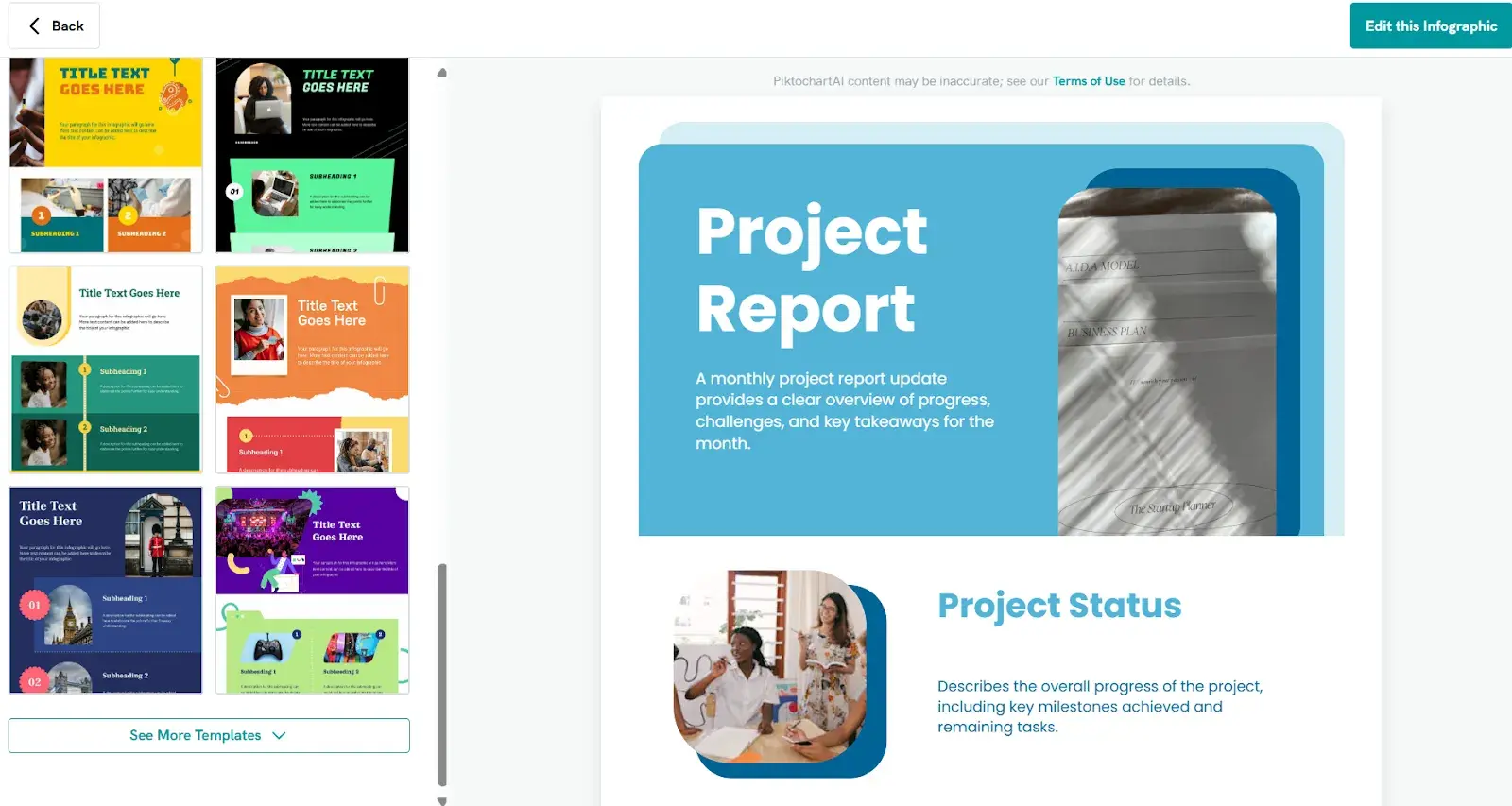
While the designs are functional, they might not be to everyone’s taste. If you're looking for a really creative or innovative template, it might take longer to find the right fit. Otherwise, you might need to put in extra work to get the look you’re looking for.
While the designs are functional, they might not be to everyone’s taste. If you're looking for a really creative or innovative template, it might take longer to find the right fit. Otherwise, you might need to put in extra work to get the look you’re looking for.
Best for: One-person marketing teams or solopreneurs who need quick, decent-looking visuals and don't mind sacrificing a bit of creativity for convenience.
What I Like
The biggest strength of Piktochart AI is the fact that it streamlines the entire design process from prompt to publishing. Navigating through the different stages felt streamlined, and I had my infographic made pretty quickly.
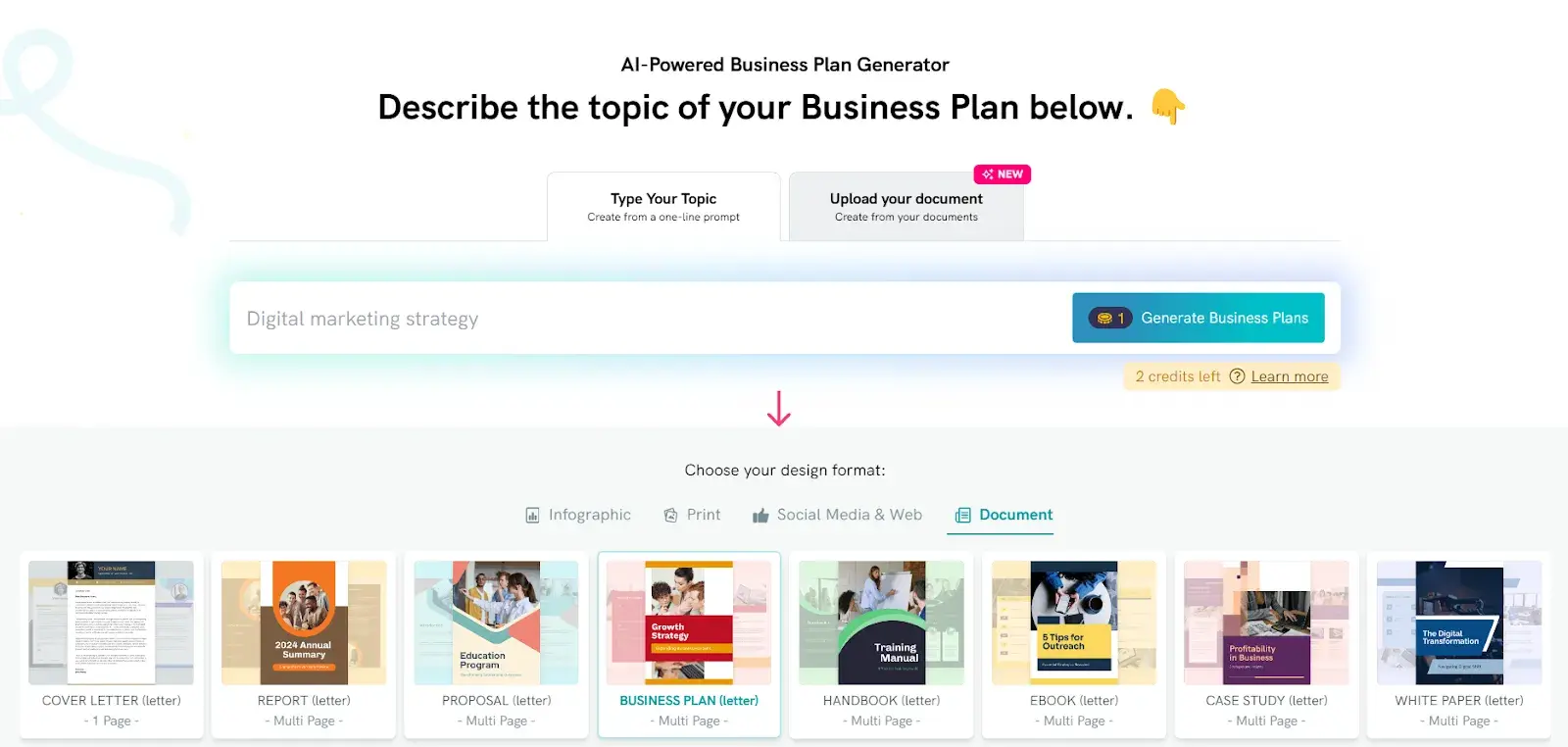
I liked how it guided me through each step and made my life simpler by signposting which visual format I could create. Infographics, reports, social media posts – you name it, they've got templates for it.
While the templates might not win creativity awards, I found most of the designs were clean and simple. For quick client-facing visuals that don't need to be super fancy, it gets the job done and more.
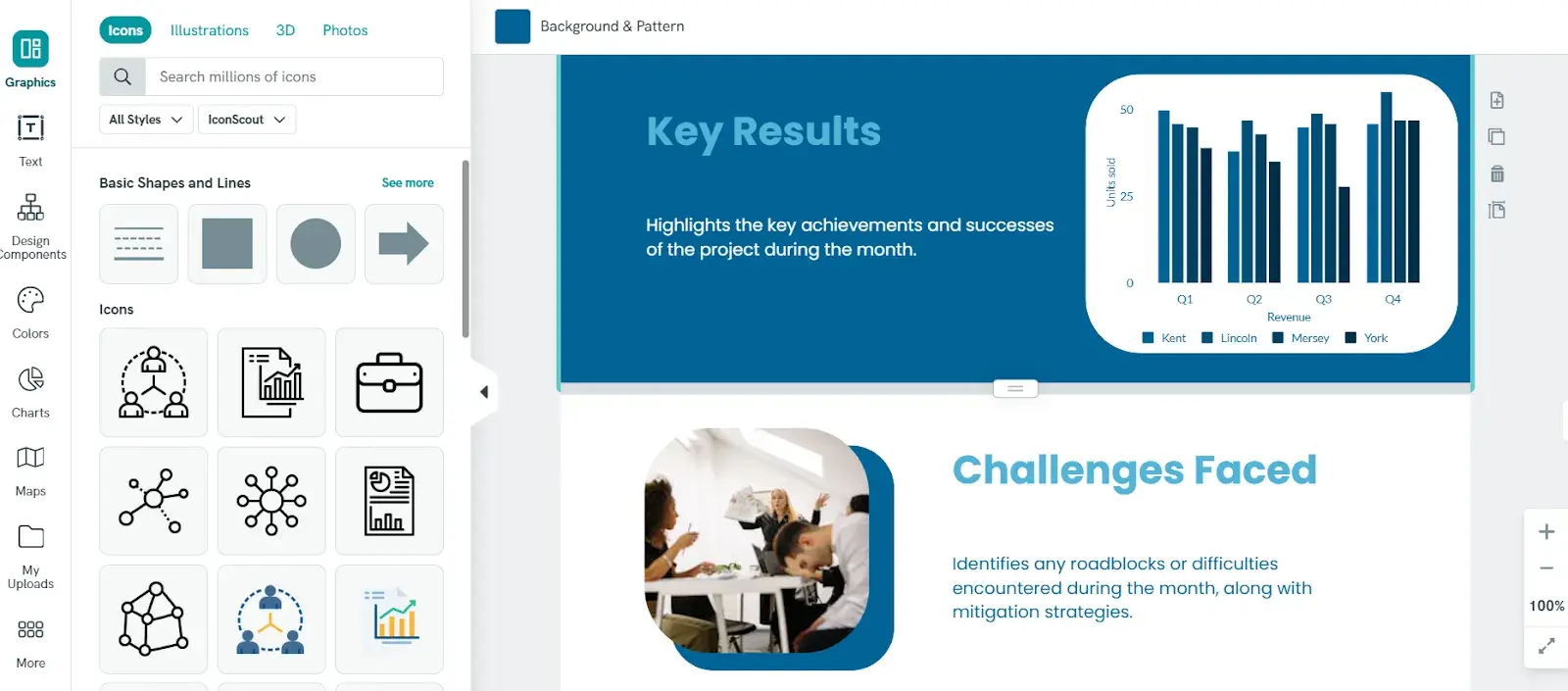
Creating a last-minute report for a client meeting didn’t require an all-nighter. It wasn’t the most stunning visual ever made, but it was professional enough and I could communicate our progress results easily.
As someone who wears multiple hats in my business, I can see the appeal of Piktochart‘s AI tool. It can create event banners, social media graphics, and even smart-looking infographics. Signing up for a paid plan is a decent option when you’re short on time and don't have the budget for a designer to create multiple visuals.
13. Sembly AI

Sembly is an advanced AI meeting assistant that not only records and transcribes meetings but also generates deliverables based on discussions. Are you looking for meeting-type aware notes? Check. Would you like to automate sales proposals or pitches? Check.
That’s how I came across this tool and tested it for the first time. At some point, I was drowning in meetings, half-legible notes, and a blog strategy with a ticking deadline. Missing it could be costly, so I decided to give it a try and asked Sembly to generate a blog strategy based on my recent team meetings. Within a few minutes, I had a comprehensive document right in front of me, and that’s how it began.
Sembly supports Google Meet, Teams, Zoom, Webex, and lets you upload video and audio recordings, so offline conversations are not off your radar. There are both native and Zapier integrations, so you can sync meeting data wherever you need.
As for the pricing, you can start with the Free plan and upgrade to the Professional for $10 or the Team for $20, billed annually.
Pros and Cons
What I like most about Sembly is its advanced AI functionality. There is no need to get separate apps to handle meeting notes, deliverables, or recordings. It is a complex solution that addresses multiple needs, and it does the job well.
Meeting information is carefully analyzed and broken down into actionable items, which makes it easy to digest. Sembly extracts risks, key decisions, requirements, upcoming events, and notable items, giving you more time to focus on what’s actually important.
In addition to that, you are not stripped of meeting notes, AI tasks, multi-meeting chat, or automations if you are on the Free plan. The core features are available regardless of the subscription. However, there is a 60-minute limit for upload and online recording time per month, meaning if you plan to spend more time on the meetings, you need to upgrade.
Best for: Solo professionals, teams, managers, and small businesses that value advanced AI features and want to optimize their meeting results.
What I Like
lWhat sold me on Sembly AI is its meeting-type awareness and the possibility to automate deliverables. Whether you need help writing a few sales pitches or would like to speed up the creation of customer agreements, Sembly delivers.
Another thing I liked was the way it supported multilingual conversations. If you work within an international team, you know what I mean. It is safe to say that each meeting resulted in accurate transcripts, so what else can you wish for?
Overall, the tool makes it easy to work with conversations, share them with the team, download transcriptions, group meetings using Collections, and sync data to CRMs (Hubspot, Salesforce, Pipedrive, etc), collaboration (Slack, Confluence, Teams), project management apps (Notion, Jira, Asana, AirTable, etc.) and more.
14. Notion AI
Notion is a tool you can use to organize your workload, run collaborative projects, and manage teams. Heck, you can even use it to take meeting notes. Notion AI is an extra offering you can add to Notion’s existing plans.
I’m a big fan of using Notion to organize projects and teams. Back when I was a content manager, I switched from Evernote to Notion after seeing how well another department manager used the tool. Even though I’m a freelancer now and don’t manage a team, I still use Notion to organize my time.

You can get started with Notion for free. However, if you want to add Notion AI to your workspace, the price starts at $8 a month per member. With Notion AI, you can access the Q&A, Autofill, and Writer core features alongside the standard organizational features of Notion.
Pros and Cons
Because the tool is easy to use and quick to learn, Notion is great for collaborative projects. After experimenting with the AI aspect of Notion, I’d say the fact that AI is integrated into the platform is a big pro. For context, this means you don’t have to go to an external AI tool to either write or access questions.
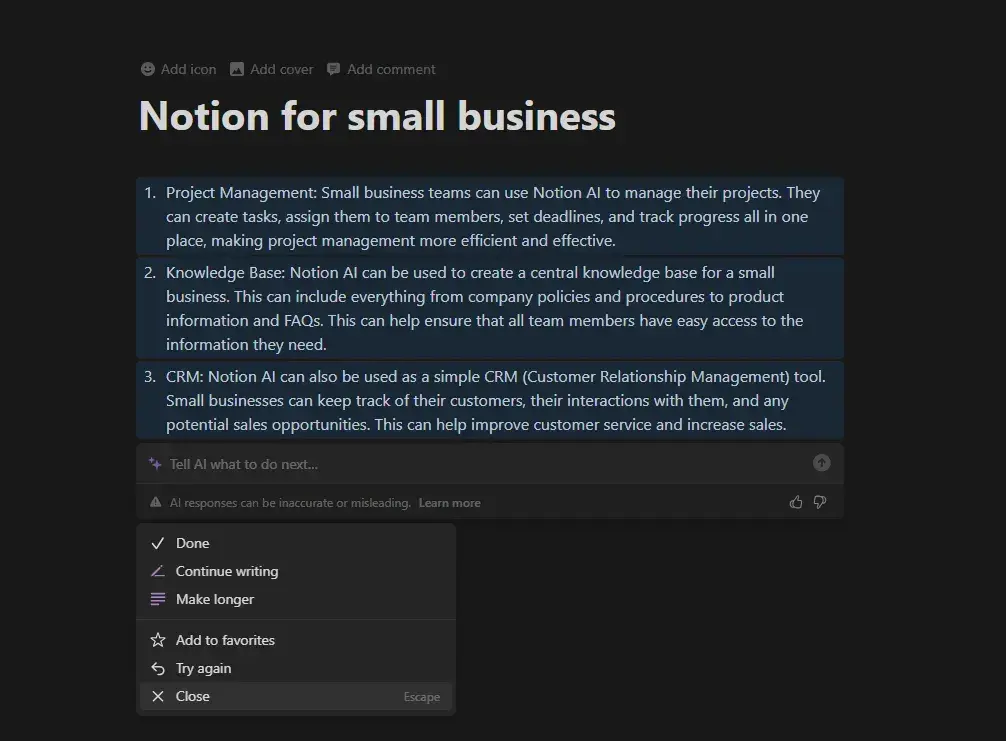
Another experiment I’ve wanted to try is asking Notion AI to help with content formatting. Shout out to Jack Virag, the senior marketing manager at Statsig, who spoke about this use case on LinkedIn. It’s one of the first content use cases for AI that genuinely piqued my curiosity.
In the below example, I’ve tested asking Notion AI to convert a title from sentence case to title case. And it worked. Imagine how much time you could save by asking Notion AI to do this for every subheading in an article. Now, consider automated formatting, such as adding bulleted lists or capitalizing all job titles depending on your company style guide. That will save a ton of time.
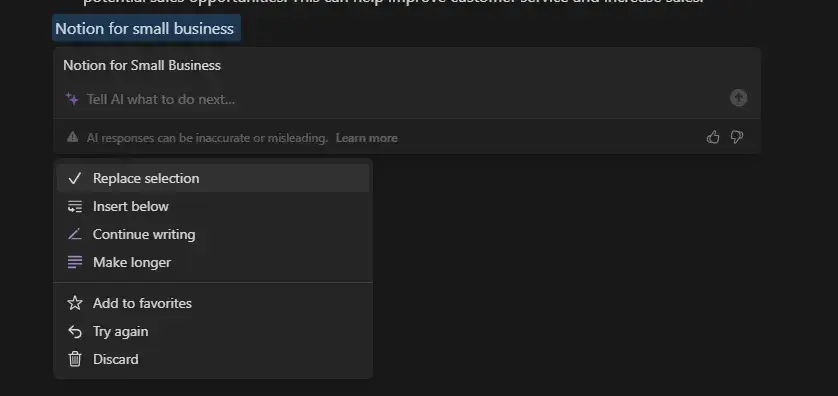
I’d say one of the biggest downsides is that the AI in Notion still has limited capabilities. It doesn’t understand some prompts, and you can only use AI within the current page you’re working on, for example. But in reality, we’re still relatively early into the AI journey in general, so you can say the same about a lot of AI tools.
Best for: Freelancers or small businesses working on internal or external collaborative projects.
What I Like
I love how simple and clean Notion’s interface is. I think this works well for creative people and projects. That’s because creative people (myself included) usually have pretty busy brains. So it’s nice to use an organizational tool that isn’t overly complex or has a lot going on visually. I personally find that this helps with my focus.
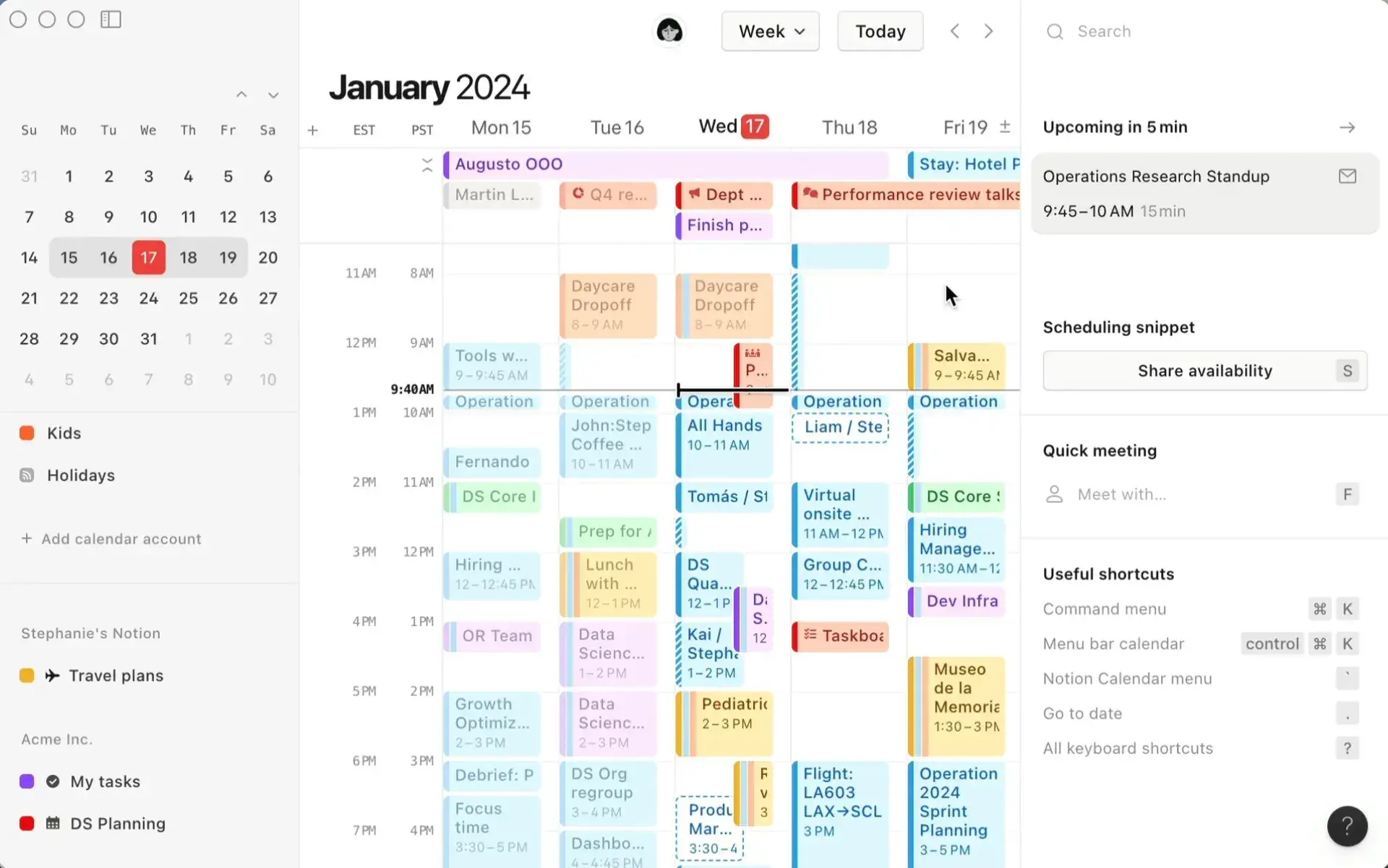
I also like that Notion acquired Cron and now offers Notion Calendar as part of its product. Notion Calendar offers “A unified way to manage all the things competing for your time.” In short, you can integrate Notion Calendar into your Google Calendar and connect events to Notion pages.
15. ChatGPT
So, what exactly is ChatGPT? Let’s hand it over to ChatGPT (or Chatty as I like to call it) so it can tell us in its own words:
“ChatGPT is an AI language model developed by OpenAI. It‘s part of the GPT (Generative Pre-trained Transformer) family of models. Essentially, ChatGPT is designed to understand and generate human-like text based on the input it receives. It’s trained on a vast amount of text data from the internet, books, articles, and more, allowing it to generate responses that are contextually relevant and coherent…”
I asked Chatty about small business use cases for the tool. According to Chatty, smaller e-commerce businesses might use a ChatGPT-powered on-site customer support chatbot that answers FAQs. This removes the cost of employing a 24/7 customer support team. Another suggestion from ChatGPT was to give customers order assistance.
When it comes to ChatGPT, I have to agree with this use case. I personally think one of the best uses for the tool is to support customer service operations.
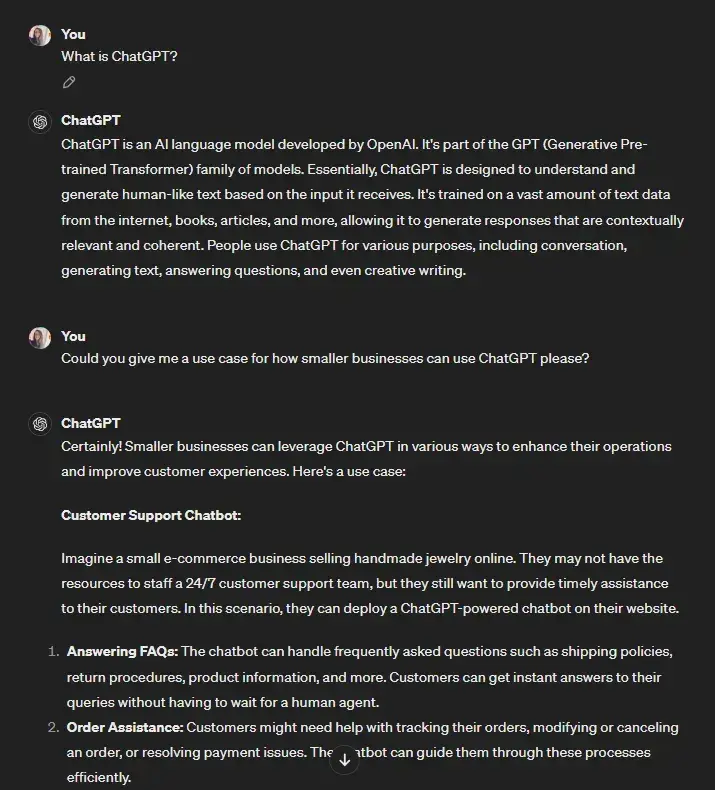
The free version of ChatGPT offers text generation, language understanding, conversation continuity, basic personalization, and general knowledge.
Pros and Cons
One of the biggest pros is OpenAI's Chat API. That means smaller businesses can create custom applications using GPT-3.5-turbo and GPT-4. If you’re a smaller e-commerce business, you can follow Chatty’s suggestion and use the Chat API to create a website chatbot with 24/7 support. Doing so can improve your customer experience.
That said, when I interviewed Cath Brands for the piece I just linked to, she warned that going fully AI for customer support could result in losing high-end customers. So, there’s a definite balance to strike when integrating AI tools into your customer service.
I’d say one of the most significant drawbacks of ChatGPT is that the content it generates can be clunky and generic. That’s why I avoid using it for writing — unless I’m using it as a research tool during the writing process. But as with Buffer’s AI writing assistant, the results could be a bit “meh” because my prompts aren’t great.
Best for: Small businesses with a need for AI-driven customer support.
What I Like
I like that you can get a quick answer from ChatGPT about various subjects. That said, it gets things wrong and is no substitute for first-hand knowledge. But if you train a ChatGPT-driven chatbot on your company training materials, it will parrot that back to customers, leaving less room for factual inaccuracies.
16. Helium 10
This is a bit of a wildcard/niche tool entrant on the list, but I tested Helium 10 for my article The Complete Guide to AI for Amazon Sellers in 2024 and loved it. Helium 10 is specifically for businesses that sell on ecommerce marketplaces like Amazon and Walmart. The Amazon sellers that I interviewed for my article recommended it.
You can get started using a free trial that doesn’t expire. However, the trial plan is quite limited compared to the paid plans. The Starter package is the most affordable paid plan at $29 per month. It comes with product research, keyword research, listing optimization, operations features, and more.
Pros and Cons
You have a lot of data at your fingertips within one dashboard. That means you can see revenue, profit, orders, refunds, and product rankings in one place. The tool also records your history, making it way easier to monitor changes and compare results based on the changes.
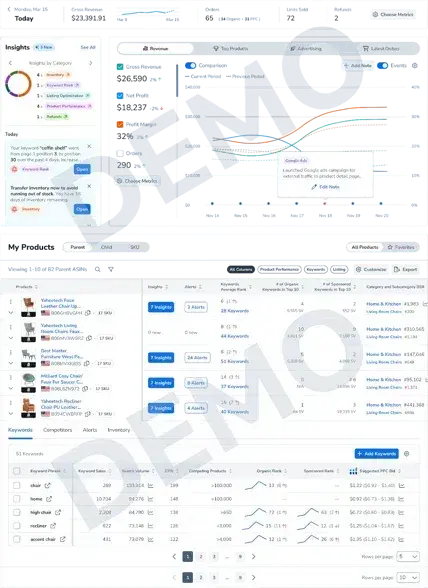
That said, the volume of data and tools on offer can make the platform overwhelming. The user interface is also quite clunky, which sometimes makes it hard to navigate the platform and find what you need.
Best for: Individual sellers, brands, and agencies.
What I Like
I like how in-depth Helium 10's analytics are. For example, you can monitor your sales, the broader market trends, and keyword rankings. Regarding AI features specifically, I think the AI-powered PPC campaigns could save Amazon sellers a chunk of time.
17. Anyword
Anyword is an AI writing platform predominantly for enterprise marketing teams. However, the tool also has a Starter package for solo marketers and freelancers.
As you can probably tell, I’m not a big fan of using AI to write content. That said, I tested this tool out for my AI for Amazon sellers article and was quite impressed. If you know what you’re doing when it comes to writing, then I think this tool could save time on content production.
There is a 7-day free trial with a limit of 2,500 words. After that, the Starter package is the most affordable at $39 per month. Starter comes with unlimited copy generation, 100+ marketing templates and prompts, and predictive performance scores and analytics.
Pros and Cons
One of the biggest pros for Anyword is the range of content templates on offer. I experimented with the “Product Listings,” but there are templates for social media, emails, and SMS.
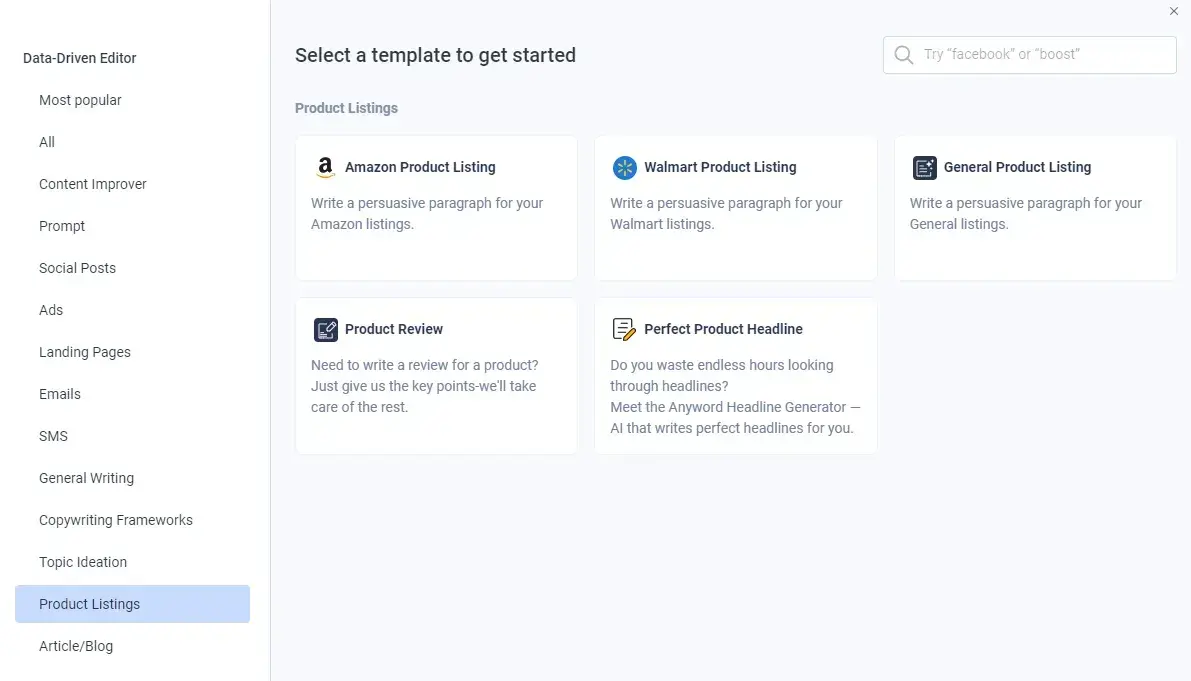
Another upside is the target audience option. I like that you can start with a “Broad Audience” and then tailor it to be more specific as you gain more data from your marketing campaigns. Once you configured this setting, Anyword gives suggestions to improve your writing based on your target audience.
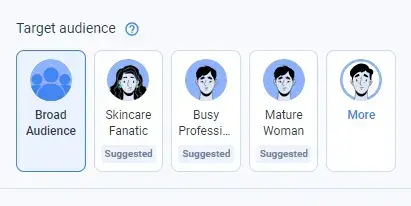
I would say the biggest downside is the cost. You get a lot with the tool, but $39 per month is on the higher end for a tool with a single specialism. If I’m being honest, the dashboard also feels a little overwhelming.
Best for: Solo marketers, freelancers, and e-commerce sellers.
What I Like
I like that Anyword comes with integrations so you can upload your existing target audiences to HubSpot, Google Ads, and Meta Ads.
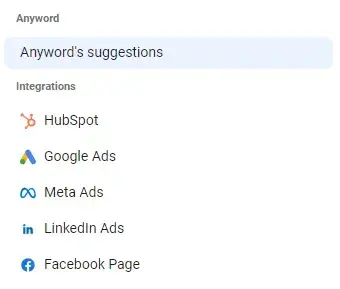
18. Trello
Trello is a great AI project management tool for smaller teams or freelancers who need to get organized without spending a fortune on software. You can get started for free — the free plan is generous in terms of features.
I’ve used Trello firsthand for marketing projects, including planning social media content and SEO blog posts involving different stakeholders. But I can see it being handy for any small business overseeing a project from start to finish.
The free plan comes with unlimited cards, up to 10 boards per Workspace, unlimited Power-Ups per board, assignee and due dates, and more.
When it comes to Trello’s AI offering, boutique agency co-founder Zoe Ashbridge, who has nine years of project management experience, says:
“Tello’s Strategy AI helps with general project management and productivity. You can use the software to control who sees what project, and projects or tasks are marked with priority to keep the team working on the most important tasks first,” Ashbridge says.
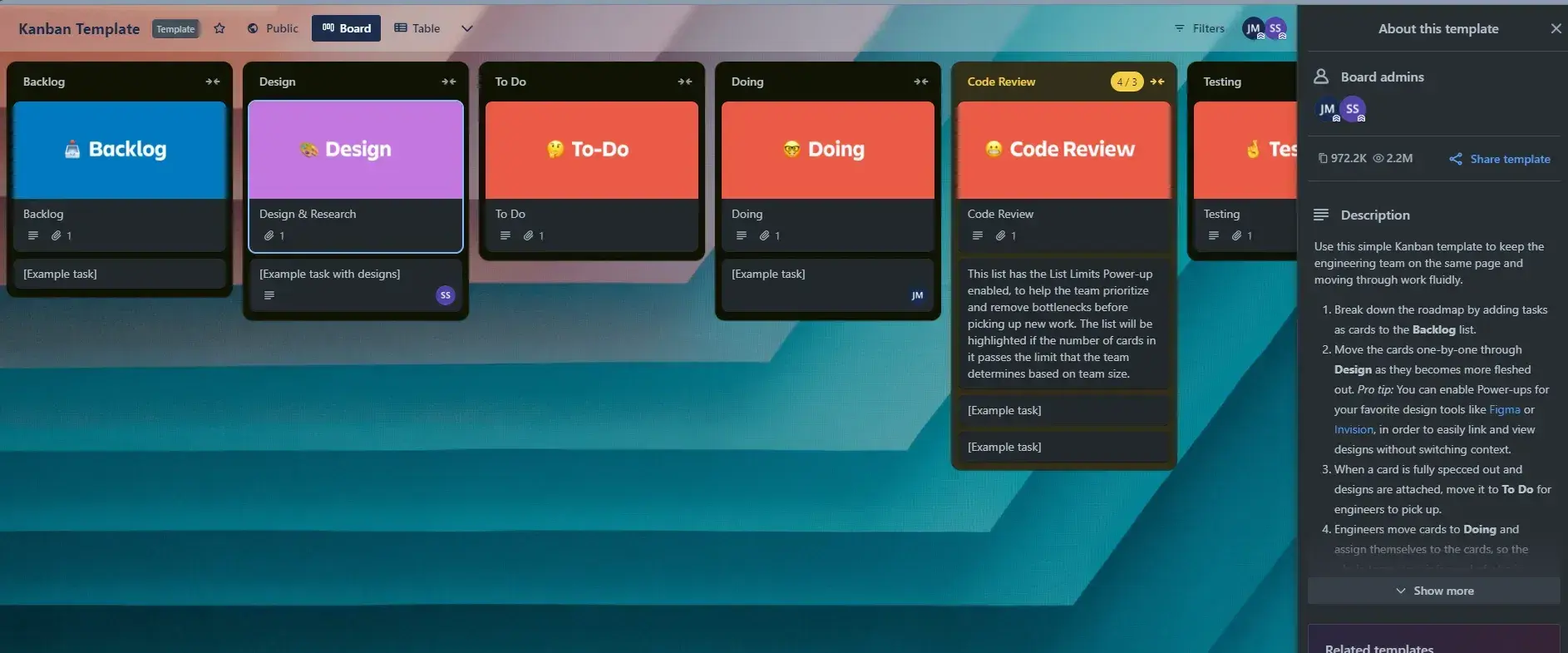
Pros and Cons
In my experience, Trello is helpful when collaborating across teams. Let me give you an example. As a content manager, I often borrowed another department's design resource specifically for video content creation. Trello was great for visibility in this context.
I’d create a card in a group board saying what I needed. The video marketer’s manager could see what I needed and approve the task. Then, set a realistic timeline based on the resource’s existing workload. The video marketer could also see what was required to complete the task and ask me any questions through the card.
Because of the visibility, it was also easier for each department to see how they could repurpose the content to get more mileage from it.
That said, I’m unsure if Trello is ideal for companies that want to scale projects or operations beyond a certain point.
Best for: Individuals or teams looking to organize any project. Small teams that need to manage work and scale collaboration.
What I Like
I’m a visual person, so I love Kanban project management. Trello is perfect for this kind of visual layout, and that’s what I love about it. The platform also offers a free Kanban template to make starting with Kanban project management on Trello even easier. I also love the simplicity of the project management tool and how it makes collaboration so much easier.
19. Secoda
Secoda is a data warehouse and AI/LLM integration for data governance, lineage, and compliance. This is another niche/wild card entrant, but I think this AI business tool has potential for small businesses with data teams gearing up to scale. Also, even in smaller companies, a ton of data can be floating around that needs to be monitored, analyzed, and managed.
It’s one of those “if only we knew when we first started” tools. This is especially true when it comes to speeding up the onboarding process for new starters, which you can do by using Secoda for your documentation.
The basic plan for “small and growing data teams to get started” comes with up to four integrations, daily syncs, data catalog, data requests, and more.
Pros and Cons
One of the biggest pros is the option for self-service business intelligence. Self-service tools like the data catalog allow team members to get quick answers about company data without raising tickets for the data team.
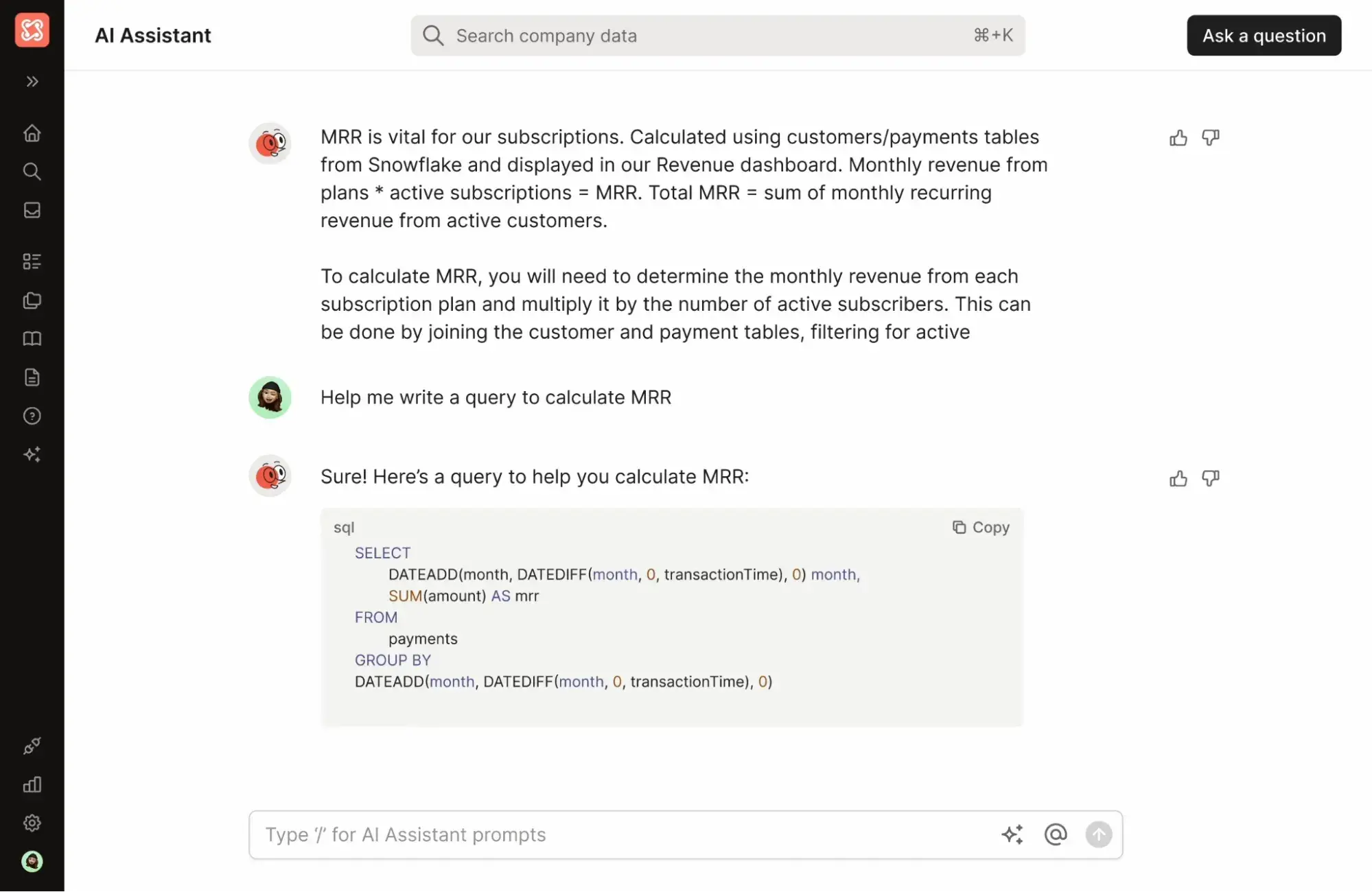
The biggest downside for smaller businesses is that the tool may be a better fit for enterprise companies. But if you need to wrangle a lot of data in your business and you want to scale operations, this could be a fit.
Best for: Small and growing data teams.
What I Like
I really like the Slack integration. Through the integration, you can wrangle data and conversations around the data in one place and then “chat” with the whole corpus.
20. SupportGPT™
I’m not the biggest advocate for AI in creative endeavors. But as I said before, I think that when used thoughtfully, AI can help in areas like customer service.
I’ve mentioned the chatbot use case. However, you can also use AI to prioritize and route support tickets to human reps. By taking on these manual tasks, AI can free up your agents to deal with more complex customer issues that require the human touch.
If you’re a small business that needs customer support, SupportGPT™ from Forethought.ai is worth considering. It’s the world's first generative AI platform specifically for customer support. The tool leverages large language models and tweaks them based on customer conversation history.
You can get started for free. The cost of paid plans depends on the number of tickets you receive and the number of agents using Forethought's AI. Core features include human-like conversations, automated workflow discovery, gap analysis and content generation, complete agent responses, and more.
Pros and Cons
This tool's biggest pro is that it offers a complete platform for the entire customer service lifecycle rather than just a chatbot. I also like the Workflow Builder, which allows support teams to build workflows quickly. Plus, the analytics feature provides data that helps you evaluate which workflows work and which don’t.
Best for: Small businesses looking to scale through AI-powered customer service.
What I Like
I really like the playground feature, which lets you build your own bot for free.
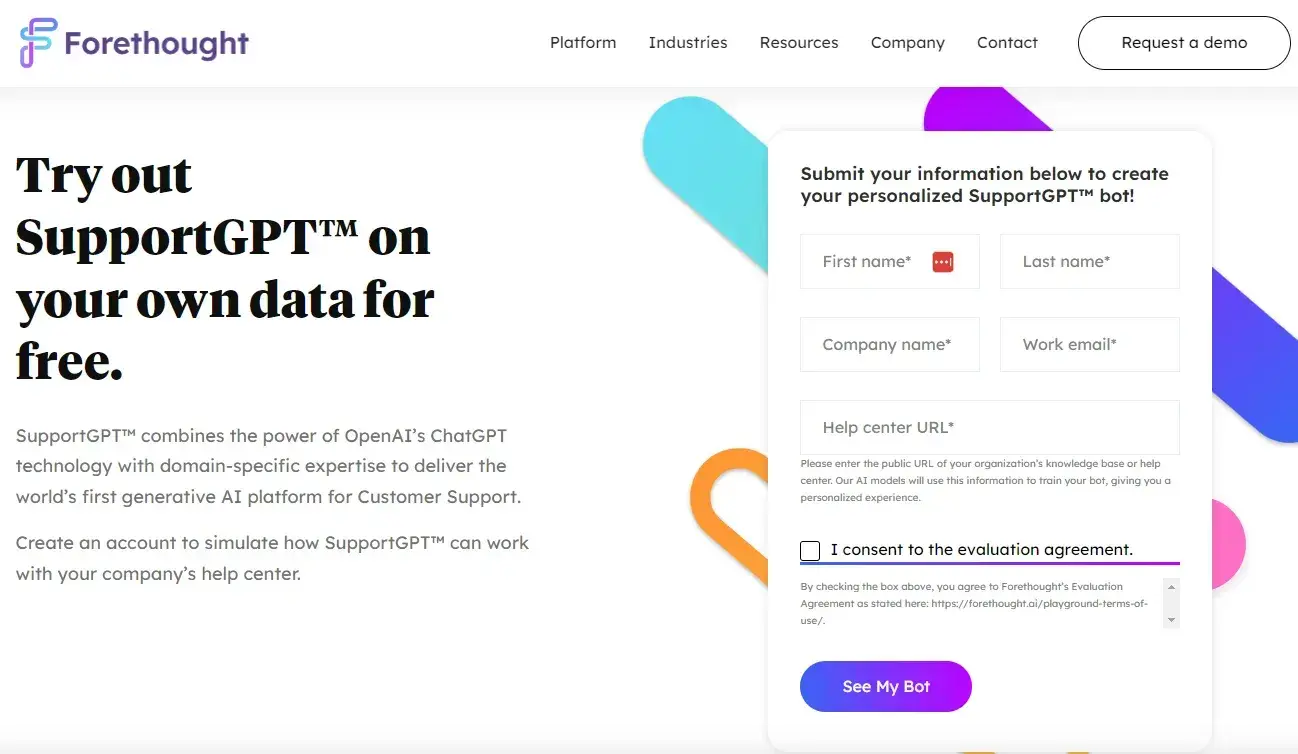
21. Botpress
Botpress is an AI agent platform designed to simplify building custom AI agents. It’s like customizing your own ChatGPT — that can connect to your existing platforms and tools — without needing extensive coding skills.
The platform offers a user-friendly interface to build any kind of customized bot. These bots are powered by LLMs, but you can design them to follow your bespoke business logic and train them on your business data (think PDFs, docs, websites, etc).
Pros and Cons
One of the biggest pros of Botpress is its transparent and affordable pricing model. You can build a bot for free without a credit card, and if you need additional features you can add them as your usage grows without having to talk to a sales person. They even give users $5 to spend on AI costs to keep it accessible to small businesses.
Another pro is its library of pre-built integrations to other platforms and channels. You can connect a custom AI agent to CRMs like HubSpot, scheduling tools like Calendly or Google Calendar, or channels like WhatsApp or Facebook Messenger – all without extensive (or any) coding.
However, while Botpress offers advanced features, there is a learning curve for its more advanced functionalities. Small business owners wanting to use the platform for more advanced use cases will need to invest time into perfecting the tool (or hire one of the company’s certified freelancers).
Best for: Small businesses who want to automate customer service, lead generation, or other business processes with AI.
What I Like
One of the things I like most about Botpress is a feature they have called their Autonomous Node. For non-technical people (like myself) it’s super useful because it allows me to write instructions in plain text and then it transforms them into an AI agent. 
Adding AI to Your Workflow
How you add AI to your workflow depends on your business, niche, and broader set-up. For example, if you’re an Amazon seller, a tool like Helium 10 will integrate naturally into your workflow. But if you’re a data team member, you might want to look into Secoda. Then, more generalist AI tools for project management and organization, like Trello and Notion, apply to most businesses.
My current favorite AI tool for my small business is Grammarly. However, historically, I’ve relied on Buffer for social media management services and love Trello and Notion for project management.
Even though AI tools can improve customer support, marketing and sales, and productivity, it’s worth considering best practices before integrating AI tools into your workflow. Data use and agreements are two critical best practices to consider.
Editor's note: This post was originally published in April 2024 and has been updated for comprehensiveness.


